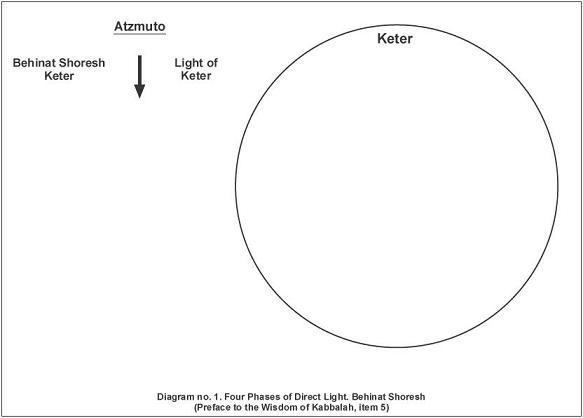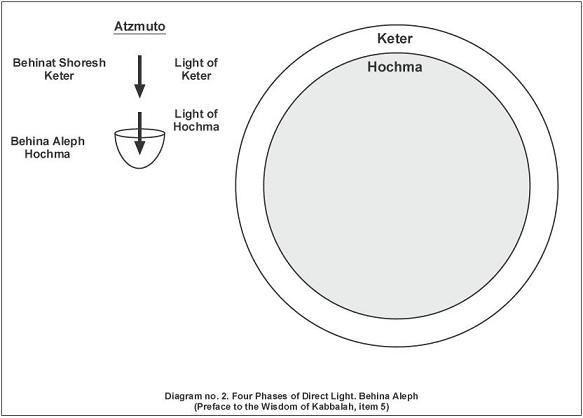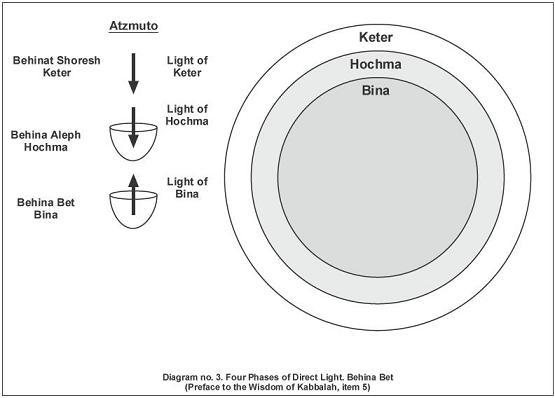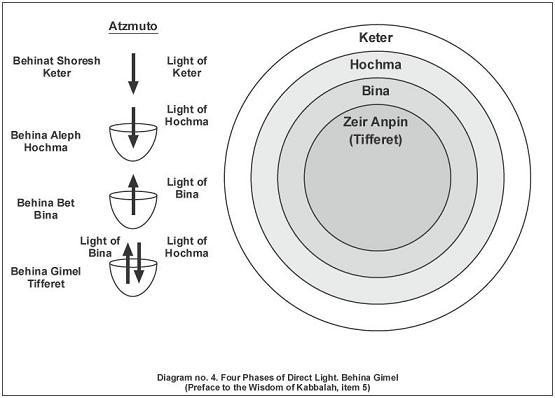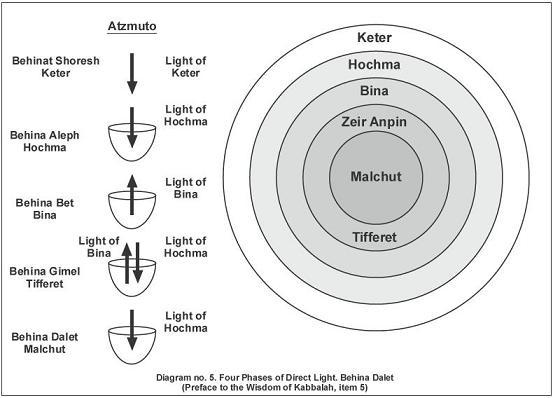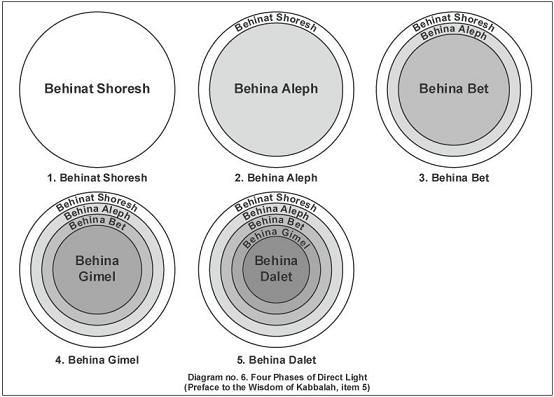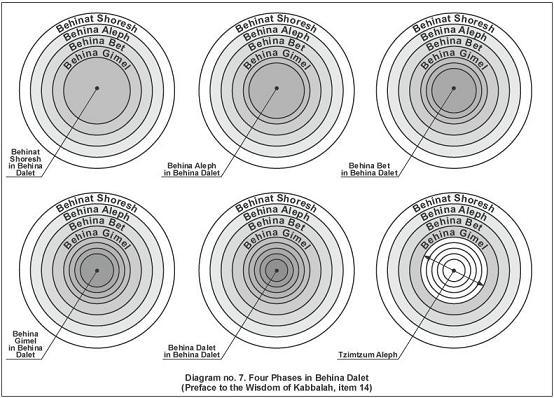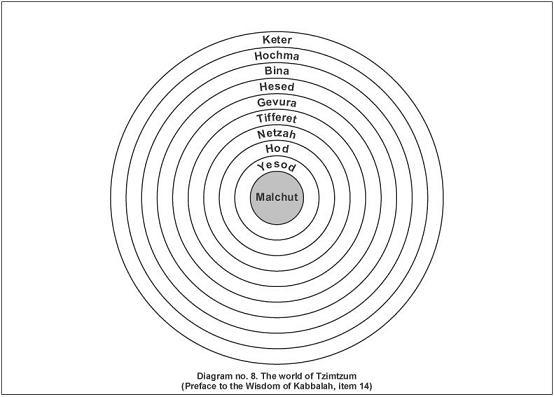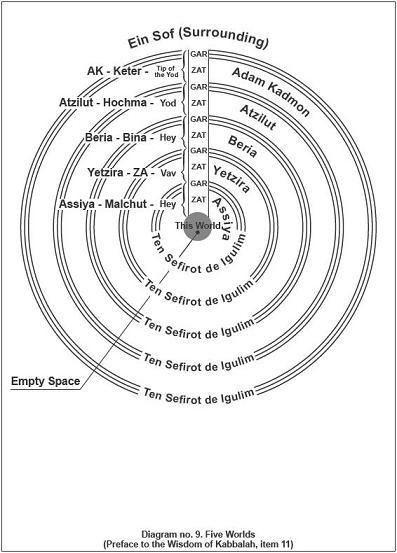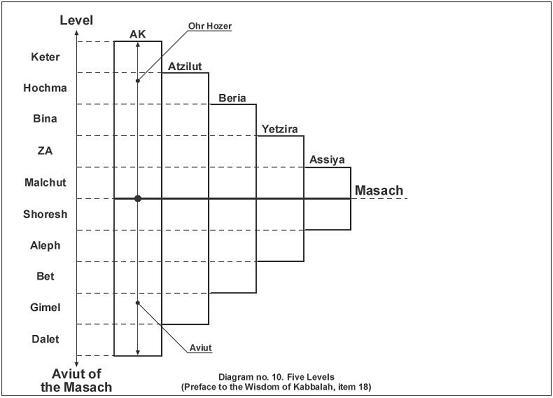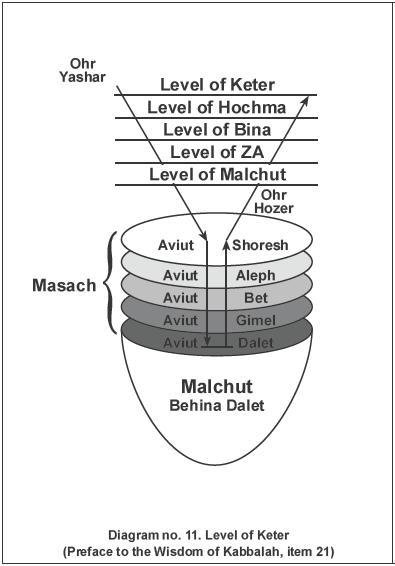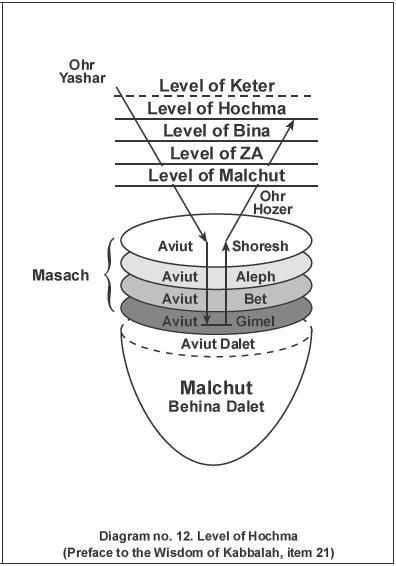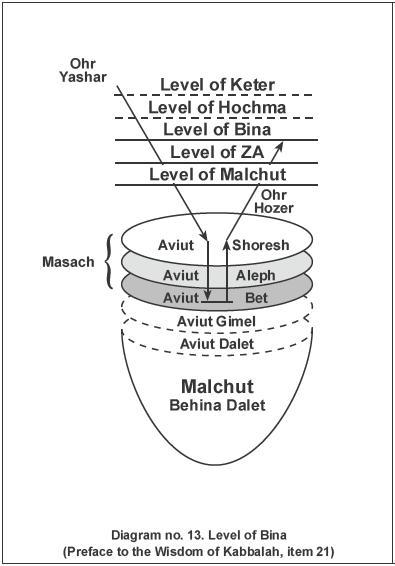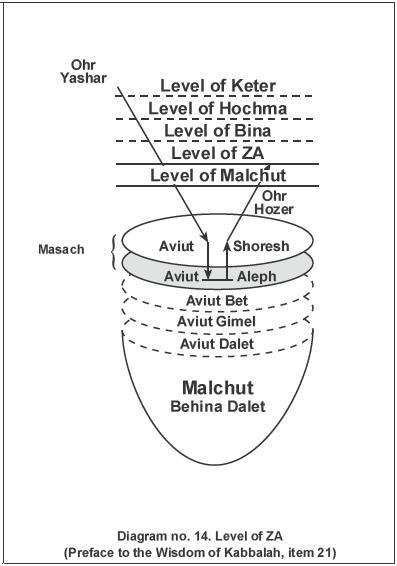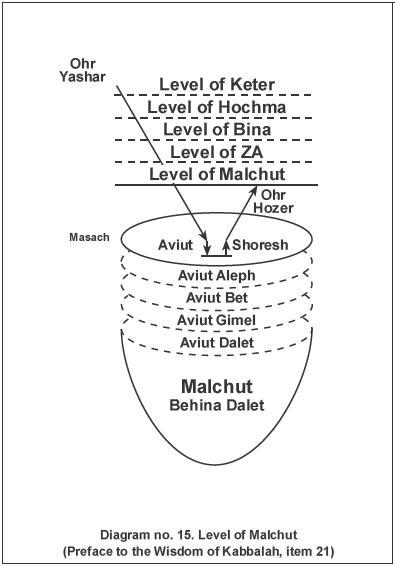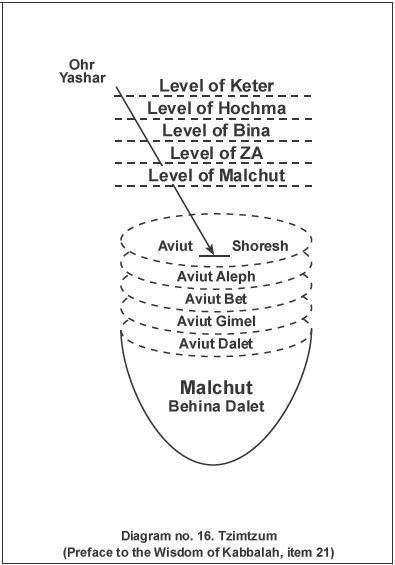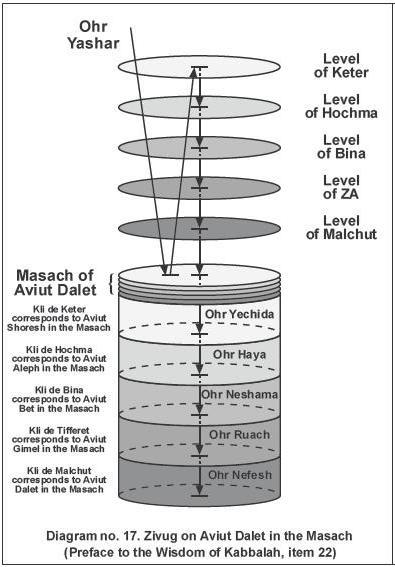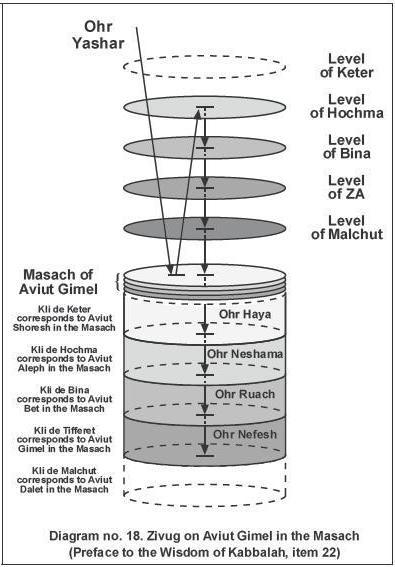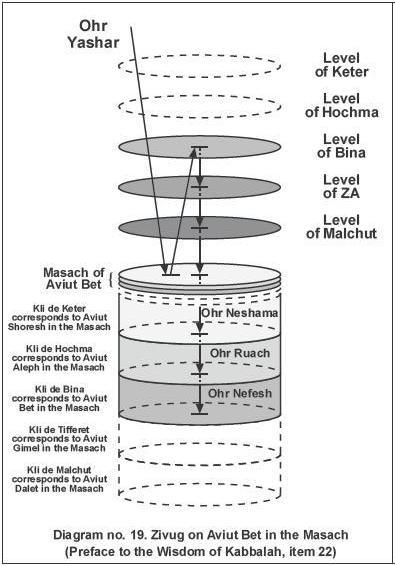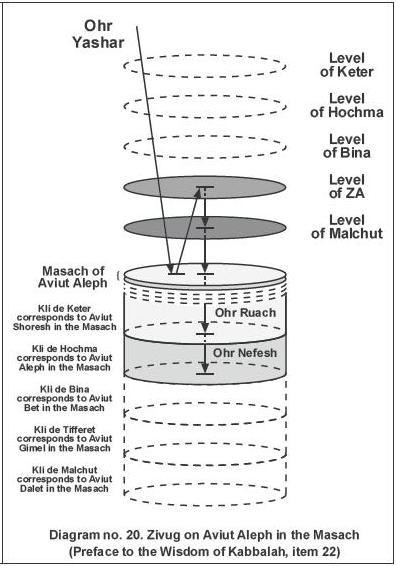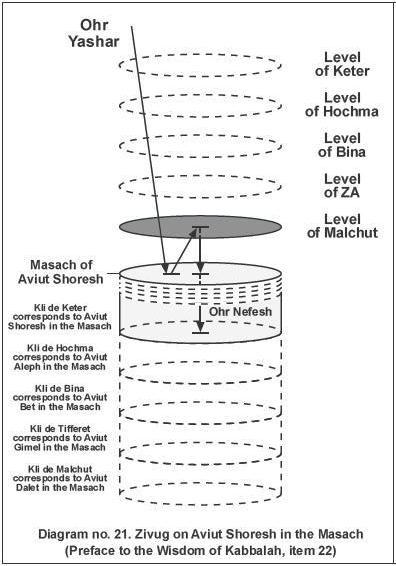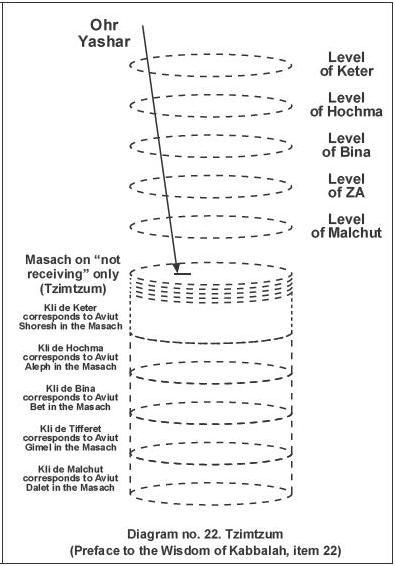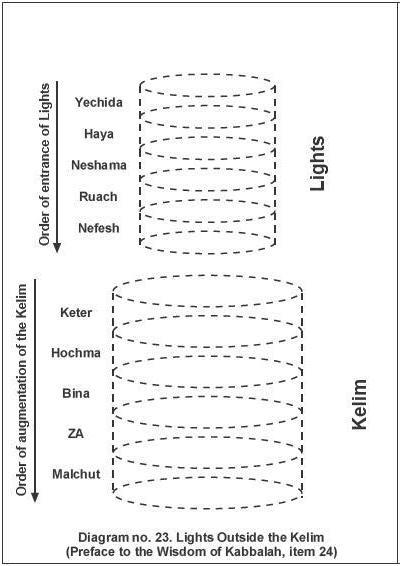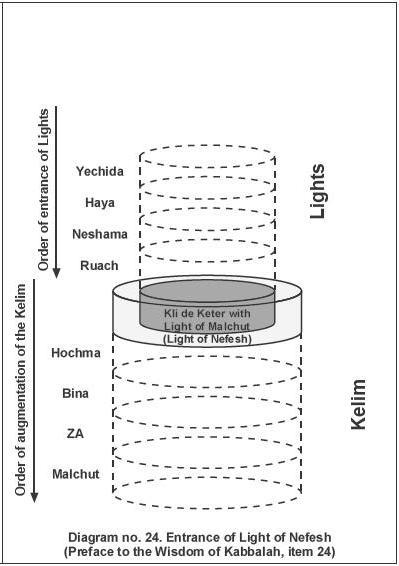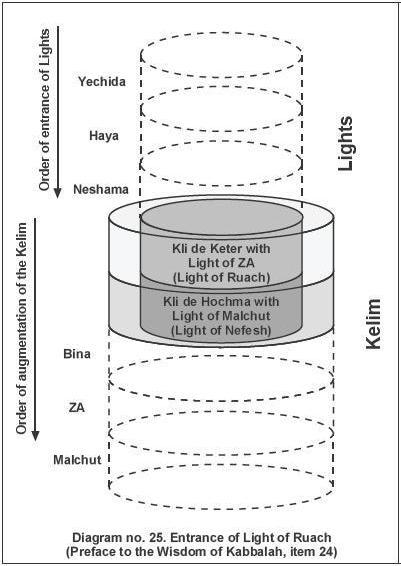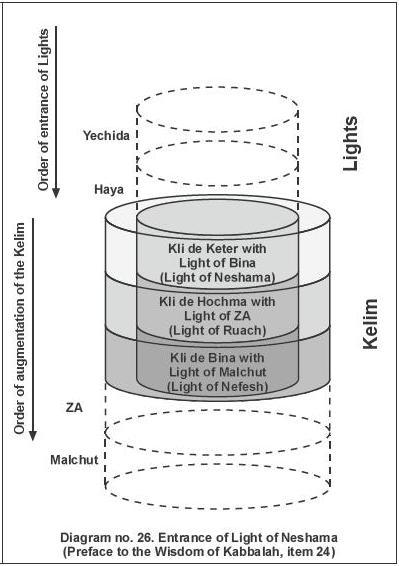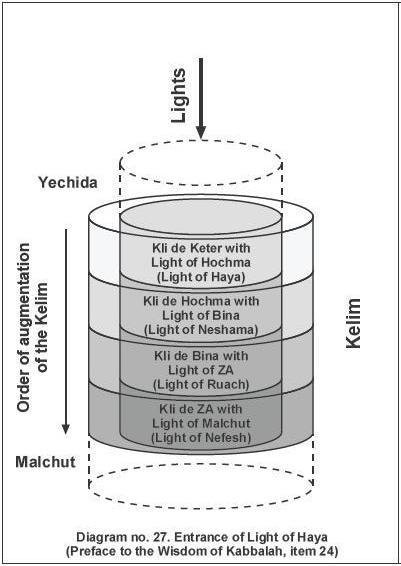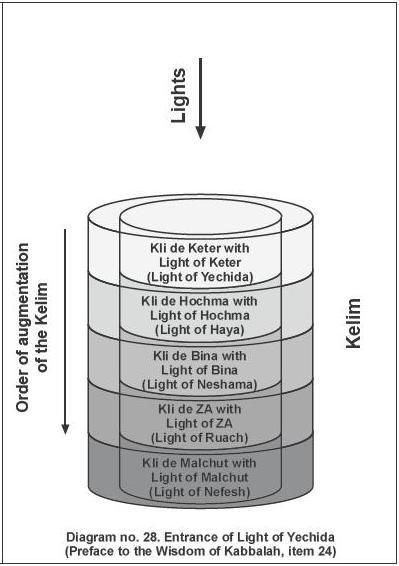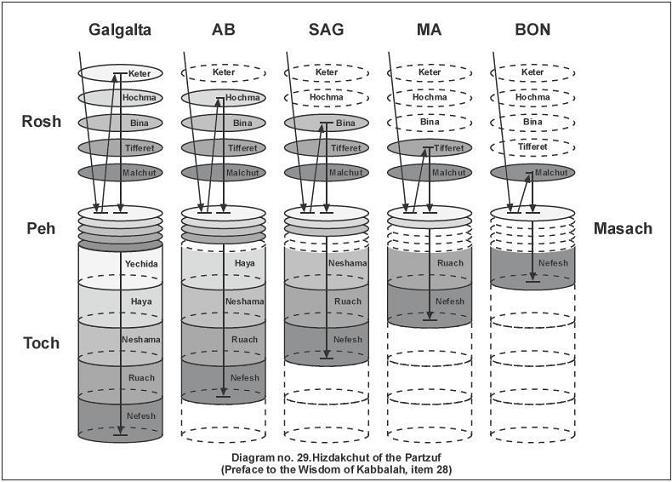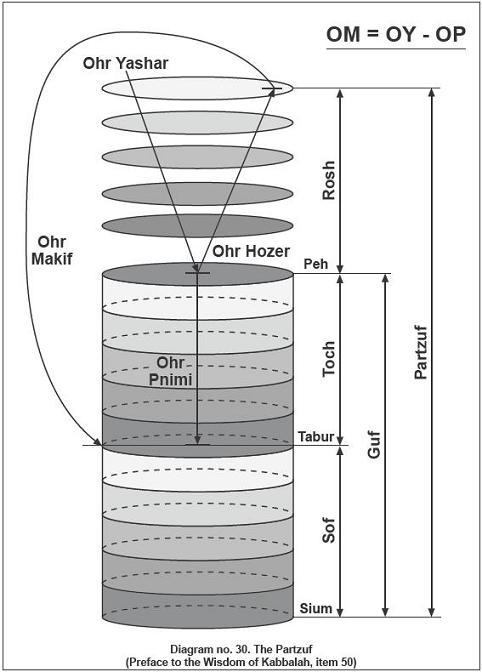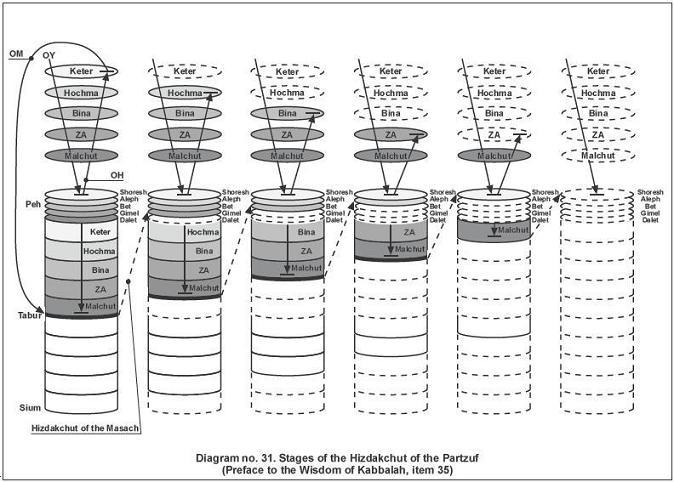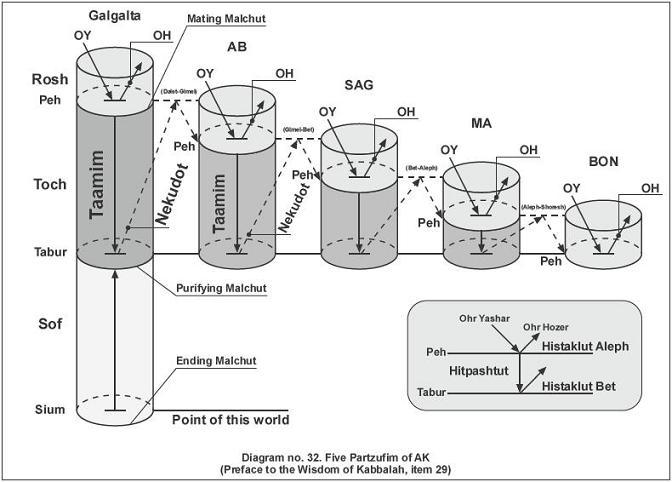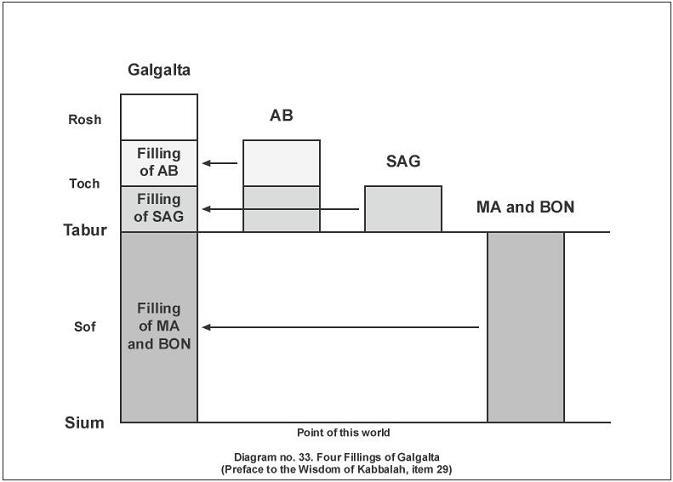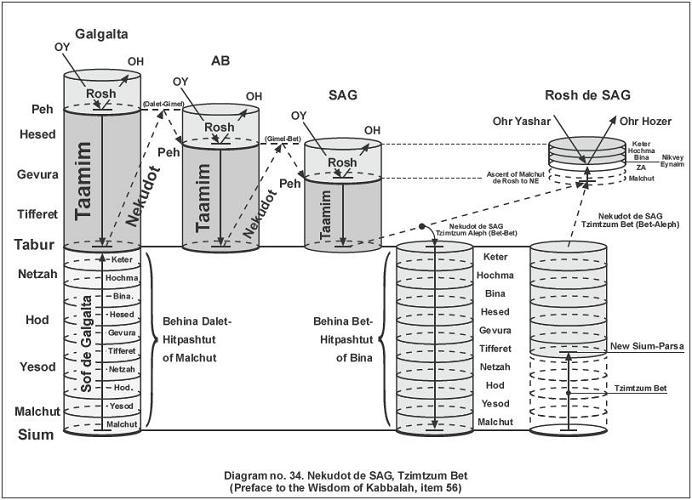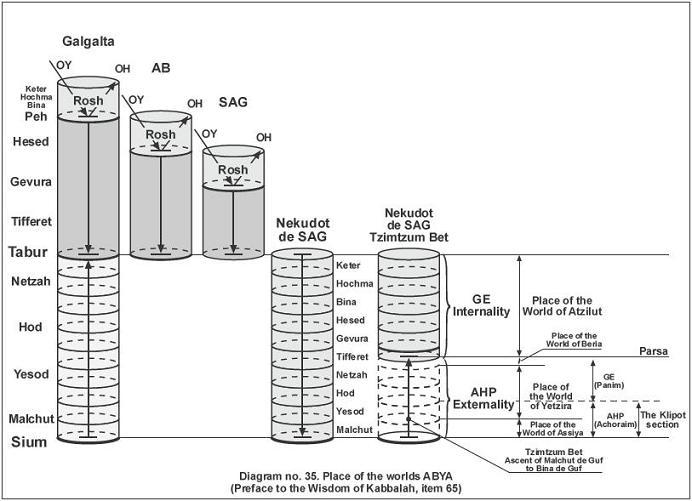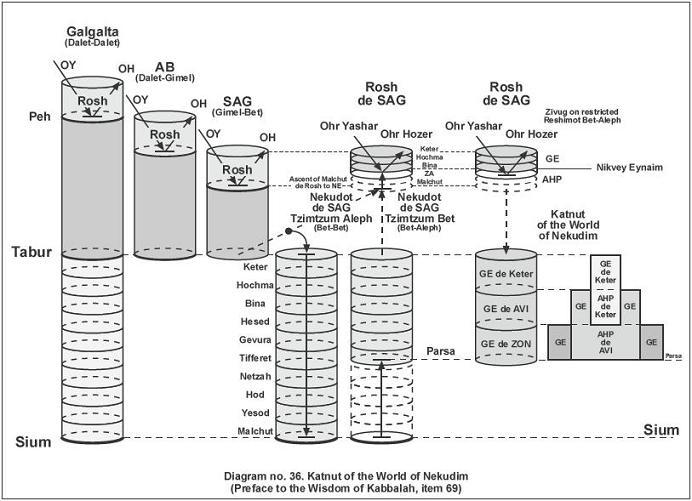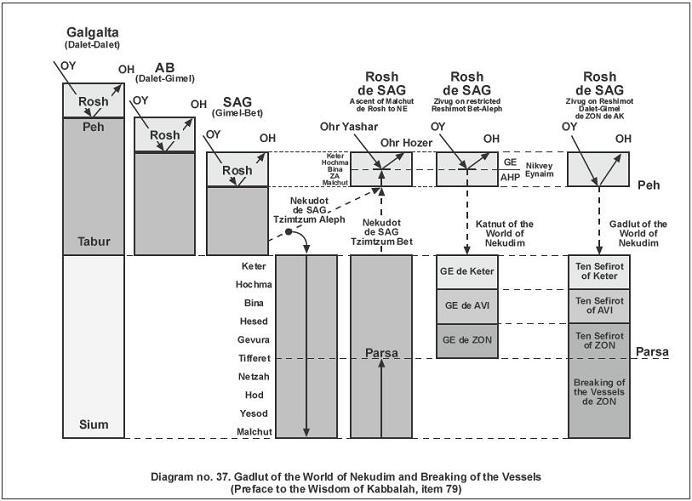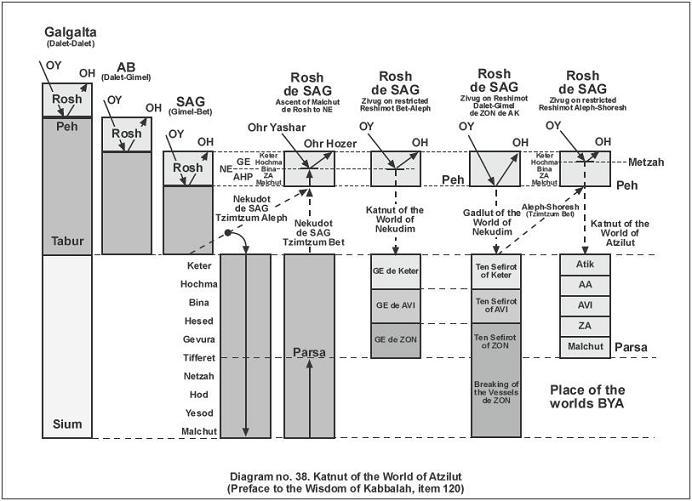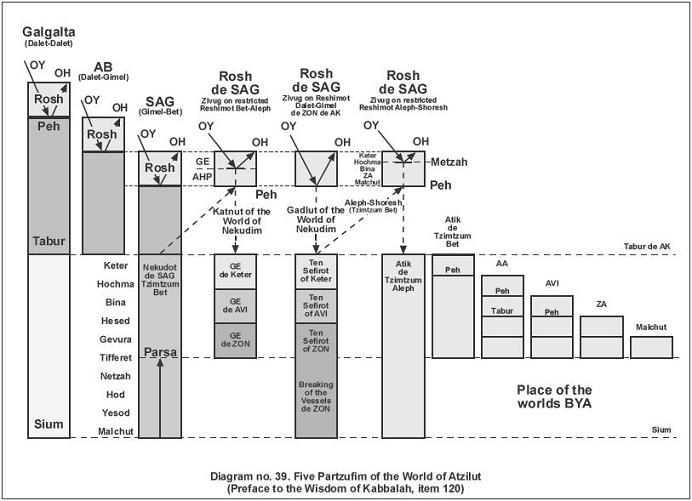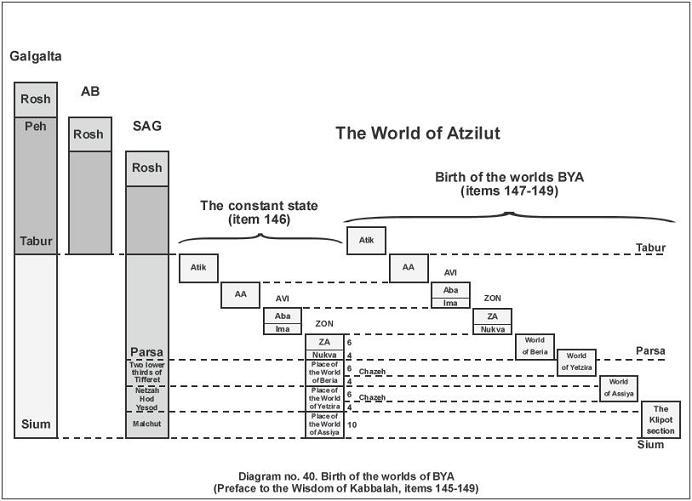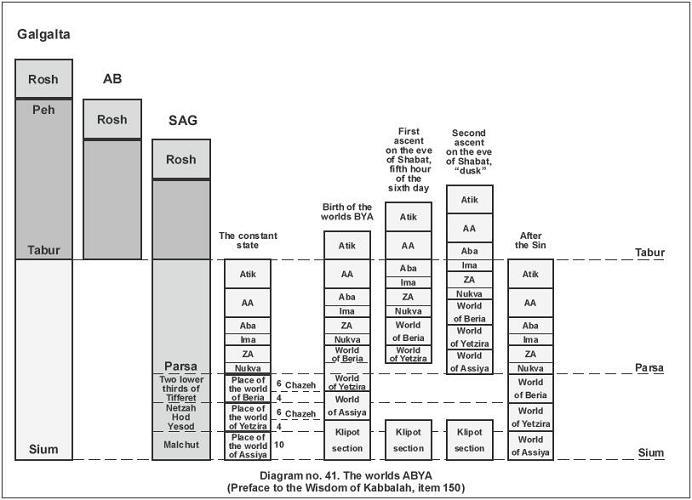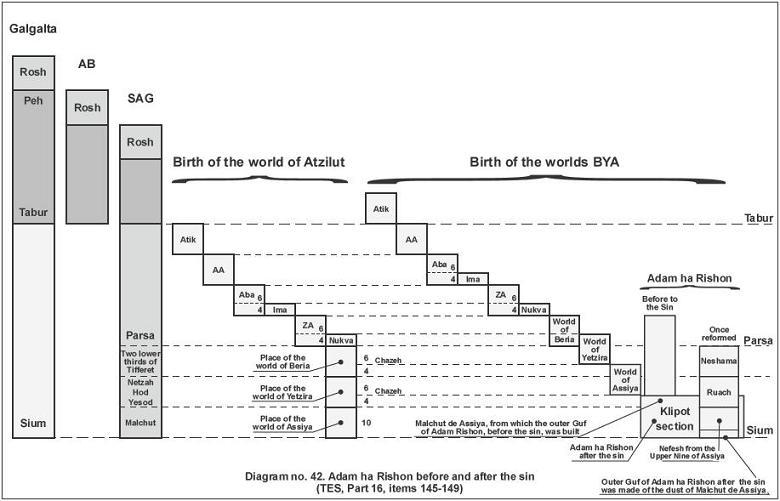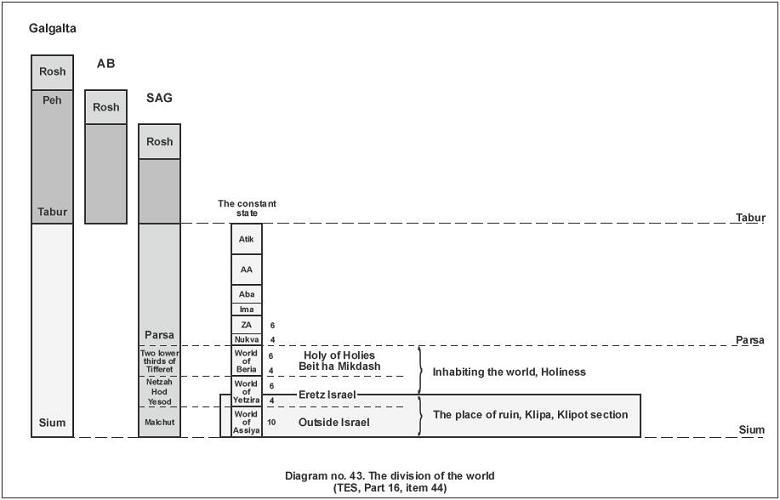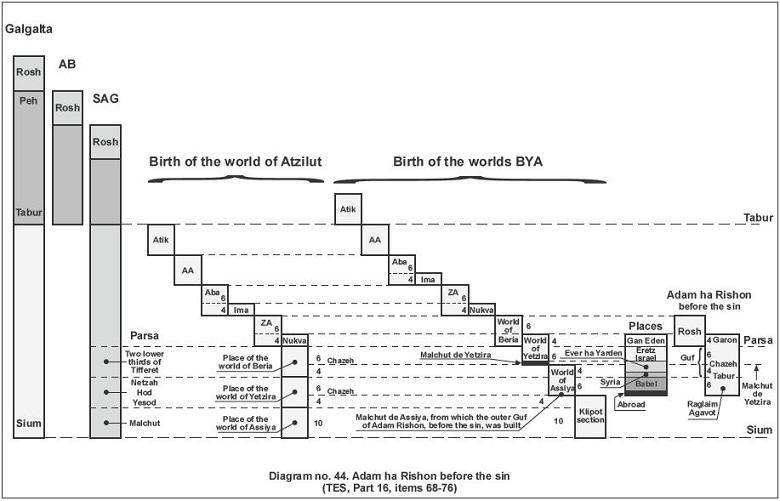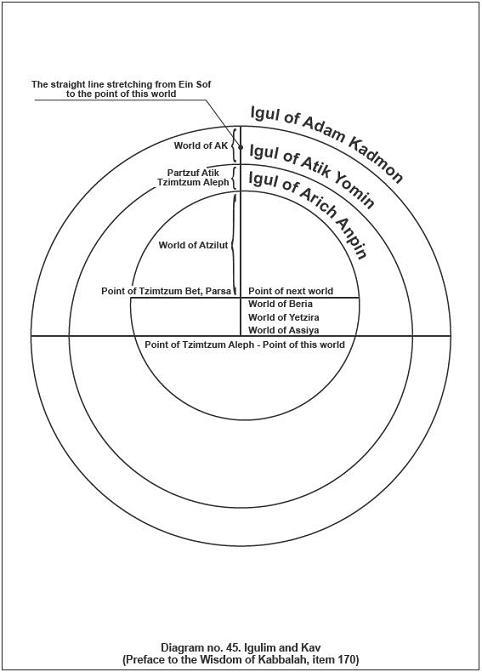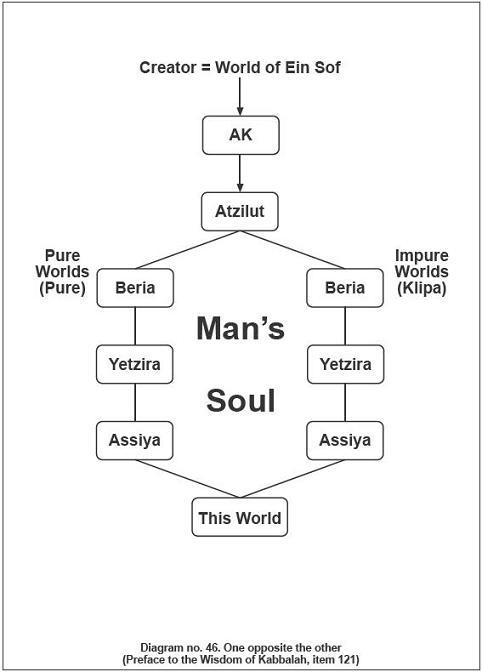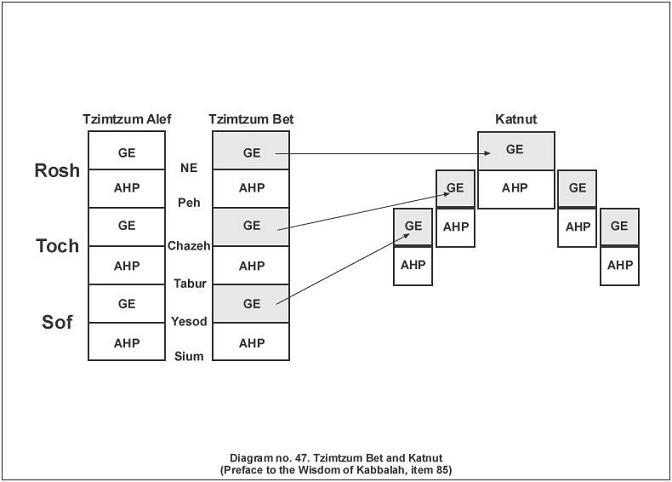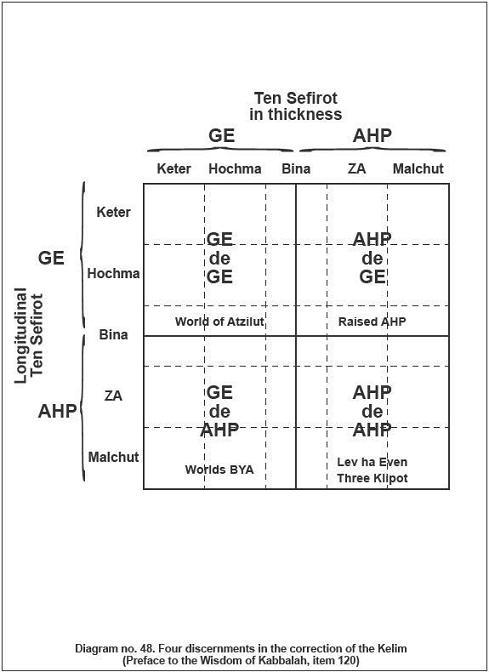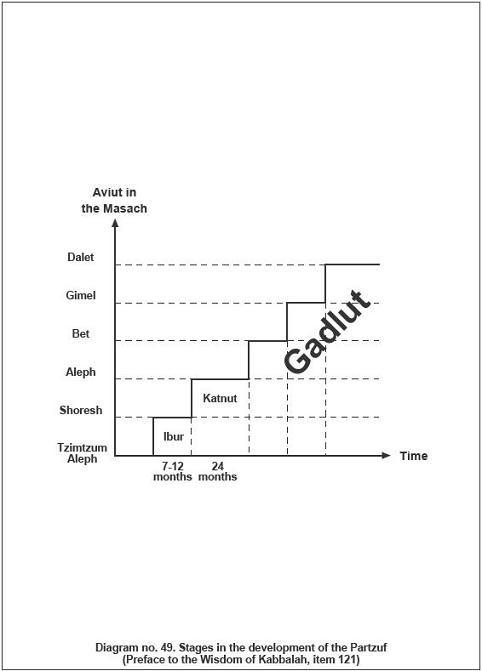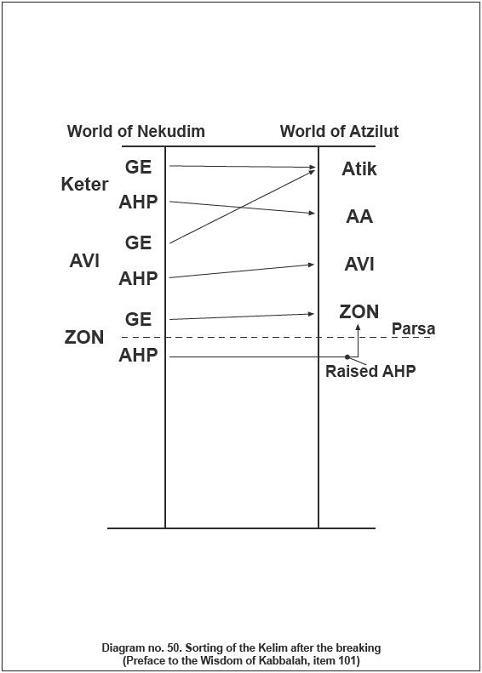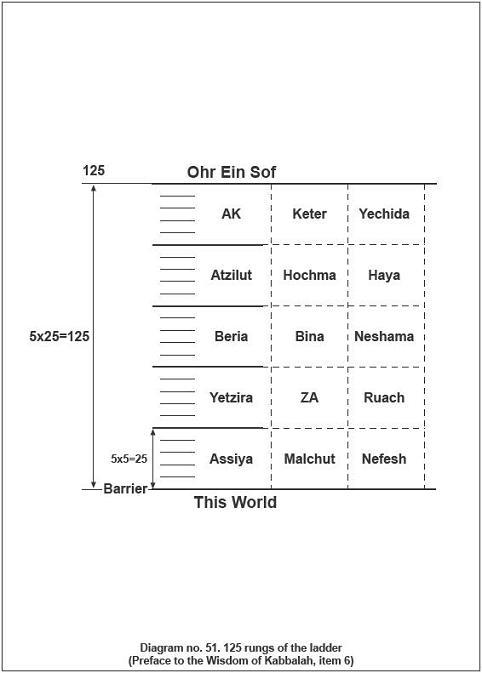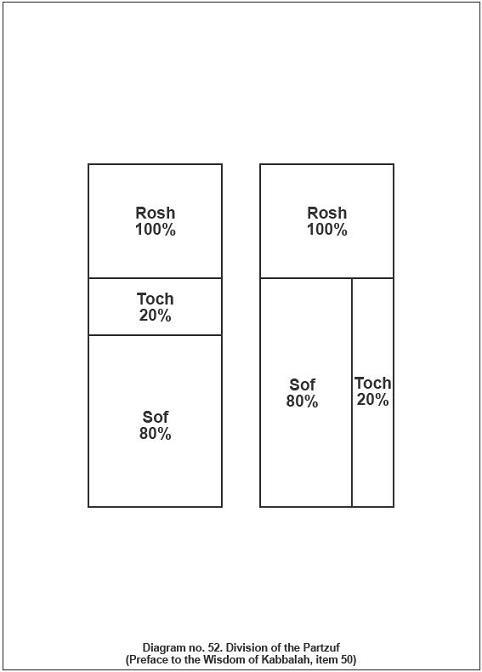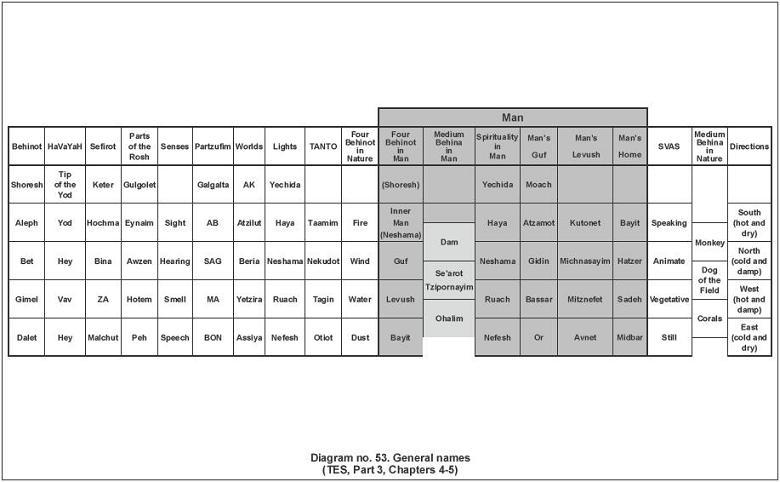Yehuda Leib HaLevi Ashlag (Baal HaSulam)
TEN SEFIROT
1) First, we must know the names of the ten Sefirot: KHB, HGT, NHYM. These are acronyms of Keter,Hochma, Bina, Hesed, Gevura, Tifferet, Netzah, Hod, Yesod, Malchut. These are also the ten coverings of His Light, established so the lower ones can receive His Light.
This is like the light of the sun, which is impossible to look at unless through darkened glass that diminishes its light and makes it suitable for the eyes’ ability to see. Similarly, had His Light not been covered by these ten coverings, called “ten Sefirot,” in which each lower one further covers His Light, the lower ones would have been unable to obtain it.
2) These ten Sefirot are the ten Holy Names in the Torah: the name Ehyeh (pronounced Ekyeh), is the Sefira Keter; the name Yah (pronounced Koh) is the Sefira Hochma; and the name HaVaYaH with punctuation of Elokim is Bina. The name El (pronounced Kel) is Hesed; the name Elohim (pronouncedElokim) is Gevura; and the name HaVaYaH with punctuation of Shvah, Holam, Kamatz is Tifferet. The name Tzvaot is Netzah and Hod; the name Shadai (pronounced Shadi) is Yesod; and the nameAdonay (pronounced Adni) is Malchut (The Zohar, VaYikra, Items 157-163, 166-177).
3) And although we count ten Sefirot, there are no more than five Behinot (discernments) in them, called Keter, Hochma, Bina, Tifferet, and Malchut. The reason why we count ten Sefirot is because the Sefira Tifferet contains six Sefirot, called Hesed, Gevura, Tifferet, Netzah, Hod, and Yesod, which makes them ten (Introduction of the Book of Zohar, “Mirrors of the Sulam,” p 5).
And these five Behinot, KHB TM are discerned in each emanated and in each creature, in all the worlds—the five worlds, called Adam Kadmon, Atzilut, Beria, Yetzira, and Assiya, which correspond to the five Behinot KHB TM—as well as in the smallest item in reality. We discern that the Rosh (head) in it is Keter; from its Rosh to Chazeh (chest) it is Hochma; from Chazeh to Tabur (navel) it is Bina; and from Tabur down it is Tifferet and Malchut.
WHY TIFFERET INCLUDES HGT NHY
4) When the five Behinot KHB TM emerged, they were incorporated in one another in such a way that each of them contained KHB TM. However, in the Sefira Tifferet, the level of the Sefirot descended from being GAR, hence the names of the KHB TM included in it changed to HGT NH, and Yesod, which contains them. Therefore, when we say that Tifferet contains six Sefirot, it is not because of its merit over the first three Sefirot, but to the contrary, it is the lack of Light of GAR in it that caused the fiveBehinot KHB TM to receive different names: HGT NH.
Thus, Hesed, is Keter, Gevura, is Hochma, and Tifferet is Bina, Netzah is Tifferet, and Hod is Malchut. The Sefira Yesod is added to them, but it is not an additional Behina (singular to Behinot) to the fiveBehinot. Rather, it is a container, which contains all five Sefirot HGT NH within it. Also, they are always called VAK, which is an acronym for Vav (six) Ktzavot (ends/edges), which are the six Sefirot HGT NHY. And since this descent of the five Behinot to HGT NHY occurred only in ZA, we ascribe the five changed Behinot only to ZA.
LIGHT AND KLI
5) It is impossible to have Light without a Kli in any of the worlds. Initially, there was only one Kli in the ten Sefirot—Malchut. The reason why we say that there are five Behinot KHBTM is that they are all parts of Malchut, called Behina Dalet. This means that they are arranged by their proximity to the complete Kli, which is Malchut, called Behina Dalet.
But after Tzimtzum Aleph (the first restriction), a Masach (screen) was erected in the Kli of Malchut, which stops the Upper Light from dressing in it. Hence, when the Upper Light reaches the Masach, the Masach strikes it and repels it. This striking is called “Zivug de Hakaa (coupling by striking) of the Upper Light with the Masach in the Kli of Malchut,” and the repelled Light is called “ten Sefirot of Ohr Hozer (Reflected Light).”
This is so because the repelled Light rises from below Upwards and clothes the ten Sefirot in the Upper Light, called “ten Sefirot of Ohr Yashar (Direct Light).” And new Kelim were made of this Ohr Hozer, to clothe the Upper Light instead of Malchut, which had been restricted so as not to receive Light. The content of those new Kelim (plural for Kli) is called “ten Sefirot of Ohr Hozer.”
ROSH-TOCH-SOF, PEH-TABUR-SIUM RAGLIN
6) And because of the new Kelim (vessels) of Ohr Hozer, each Partzuf is discerned with three parts, called Rosh, Toch, Sof (Head, Interior, End). It has been explained that by the force of the Masach that stops the Light from reaching Malchut, there was a Zivug de Hakaa with the Light, which produced the ten Sefirot de (of) Ohr Hozer and clothed the ten Sefirot de Ohr Yashar in the Upper Light.
These ten Sefirot de Ohr Yashar and Ohr Hozer are called “ten Sefirot de Rosh.” However, these tenSefirot de Ohr Hozer, which emerged from the Masach upwards and clothe the ten Sefirot de Ohr Yashar, are still not actual Kelim. This is because the name, Kli, indicates the Aviut in it, that is, the force of Din (judgment, restriction) in the Masach, which prevents the clothing of the Light inMalchut.
There is a rule that the Din force operates only from the place of the emergence of the Dindownwards, not from the place of the emergence of the Din Upwards. And since the ten Sefirot de Ohr Hozer emerged from the Masach Upwards, the Din force is not apparent in the Ohr Hozer and is unfit to be a Kli. For this reason, these ten Sefirot de Ohr Hozer are called Rosh, that is, a root for theKelim, and not actual Kelim.
And Malchut, in which the Masach for the Zivug de Hakaa had been established, is therefore calledPeh (mouth). This implies that as in a corporeal mouth, where Otiot (letters) are made through aZivug de Hakaa of the five outlets of the mouth, the spiritual Peh contains a Zivug de Hakaa to produce ten Sefirot de Ohr Hozer, being the five Behinot KHB TM, which are the Kelim for the tenSefirot de Ohr Yashar, and Kelim are called Otiot. Thus, the ten Sefirot de Rosh have been explained.
7) Thus, the ten Sefirot de Ohr Yashar and ten Sefirot de Ohr Hozer had to expand from the Masach downwards, at which time the ten Sefirot de Ohr Hozer became Kelim that receive and clothe the tenSefirot de Ohr Yashar. This is because now there is a Masach over the ten Sefirot de Ohr Hozer. For this reason, its thickness controls the ten Sefirot de Ohr Hozer, and by that the Kelim were made.
Also, these ten Sefirot, which are actual Kelim, are called Toch and Guf (body), that is, they are the very insides and the Guf of the Partzuf. And Malchut of the Toch is called Tabur, as in the phrase, “the Tabur (navel, center) of the land,” referring to the center and the middle. This indicates thatMalchut de Toch is the central Malchut, and it is from her Ohr Hozer that the actual Kelim of the Gufwere made.
It can also be said that Tabur comes from the words, Tov Ohr (Good Light), indicating that thus far the Light is good, as it is dressed in Kelim that are suitable to receive it. Thus we have explained the ten Sefirot de Toch through the Tabur.
8) Thus, we find two discernments in Malchut de Rosh:
- The Ending Malchut: the Masach’s detaining of the Upper Light from clothing in the Kli of Malchut.
- The Mating Malchut: Had it not been for the Zivug of the Upper Light with the Masach through a Zivug de Hakaa, which raises Ohr Hozer to clothe the Upper Light, there would be no vessels of reception in the Upper Light, and there would be no Light in reality, since there is no Light without a Kli.
But in Malchut of the Rosh, these two discernments are only two roots. The ending Malchut is the root of the Malchut that ends the degree, and the mating Malchut is the root of the clothing of Light in the Kelim.
Both these actions appeared and occurred in the Guf of the Partzuf:
- From Peh to Tabur, the mating Malchut shows its strength there, and the Upper Light is clothed in Kelim.
- And from Tabur down, the ending Malchut shows its strength and produces ten Sefirot de Sium(ending). Each Sefira emerges with illumination of only Ohr Hozer, without the Upper Light. And when it reaches the Malchut of these ten Sefirot de Sium, the entire Partzuf ends. This is because this Malchut is the ending Malchut, which does not receive anything, and hence ends the expansion of the Partzuf.
And we call this Malchut, Malchut de Sium Raglin, which cuts the Light and ends the Partzuf. And these ten Sefirot de Sium that expand from the Tabur down to its Sium Raglin are called “ten Sefirot de Sof” (end), and they are all parts of the Malchut of Sof and Sium. Also, when we say that there is only Ohr Hozer in them, it does not mean that they have no Ohr Yashar at all. Rather, it means that they do have some illumination of Ohr Yashar, but it is considered VAK without a Rosh.
CHAZEH
9) Thus far we have discussed the Partzufim (plural for Partzuf) of Adam Kadmon. But in thePartzufim of the world of Atzilut, another Sium was added in the ten Sefirot de Toch: Malchut de Toch, called Tabur, rose to Bina of the ten Sefirot de Toch, and ended the ten Sefirot of the Tochdegree there. This Sium is called Chazeh, and the Parsa has been set there.
This means that the new Sium that was made by the ascension of Malchut to Bina at the place of theChazeh is called Parsa (diaphragm, midriff), as in the firmament that separates the Higher Waters —Keter and Hochma that remained in the Toch degree—from Bina and TM, which departed from the degree of ten Sefirot de Toch and became the degree of ten Sefirot de Sof.
For this reason, the ten Sefirot de Toch were divided into two degrees:
- From Peh to Chazeh it is considered ten Sefirot de Toch, Atzilut, GAR of the Guf.
- From the Chazeh down to Tabur, it is considered ten Sefirot de Sof, Beria, VAK without a Rosh, like the ten Sefirot de Sof.
INVERSE RELATION BETWEEN KELIM AND LIGHTS
10) There is always an inverse relation between Lights and Kelim. In the Kelim, the order is that Upper Ones are the first to grow in a Partzuf. First, Keter comes to the Partzuf, then Hochma, thenBina, then Tifferet, and then Malchut. For this reason, we name the Kelim KHB TM, that is, from Above downwards, because so is their order of appearance in the Partzuf.
But the Lights are opposite. The order of the Lights is that the lower ones enter the Partzuf first. The first to enter is the Light of Nefesh, then the Light of Ruach, then the Light of Neshama, then the Light of Haya, and then the Light of Yechida.
Thus, in the beginning comes the Light of Nefesh, which is the Light of Malchut, the smallest of all the Lights. And the last to come is the Light of Yechida, the biggest of all the Lights. This is why we always name the Lights NRNHY, that is, from below Upwards, as this is their order of entering thePartzuf.
11) It therefore follows that while there is only one Kli in the Partzuf, which is necessarily the HighestKli—Keter—which is the first to emerge, the great Light related to Keter, the Light of Yechida, does not enter the Partzuf. Rather, the Light that enters and clothes in Kli de Keter is the smallest Light, the Light of Nefesh.
And when two Kelim grow in the Partzuf, which are the greater Kelim—Keter and Hochma—the Light of Ruach enters, too. In that state, the Light of Nefesh descends from Kli de Keter to Kli de Hochma, and the Light of Ruach clothes in Kli de Keter. Similarly, when the third Kli grows in the Partzuf—theKli of Bina—the Light of Neshama enters the Partzuf. In that state, the Light of Nefesh descends from the Kli of Hochma to the Kli of Bina, the Light of Ruach leaves the Kli of Keter and enters the Kli ofHochma, and the Light of Neshama dresses in the Kli of Keter.
And when a fourth Kli grows in the Partzuf, being the Kli of Tifferet, the Light of Haya enters thePartzuf. In that state, the Light of Nefesh descends from the Kli of Bina to the Kli of Tifferet, the Light of Ruach to the Kli of Bina, the Light of Neshama to the Kli of Hochma, and the Light of Haya to theKli of Keter.
And when a fifth Kli grows in the Partzuf, the Kli of Malchut, all the Lights enter their respectiveKelim. This is because then the Light of Yechida is drawn into the Partzuf: the Light of Nefesh descends from Kli de Tifferet to the Kli of Malchut, the Light of Ruach descends from Kli de Bina and enters the Kli of Tifferet, the Light of Neshama descends from Kli de Hochma and enters the Kli ofBina, and the Light of Haya descends from Kli de Keter and comes into the Kli of Hochma, and the Light of Yechida comes and clothes in the Kli of Keter.
12) You find that as long as not all five Kelim KHB TM have grown in the Partzuf, the Lights are not in their designated places. Moreover, they are in inverted ratio, since if the Kli of Malchut—the smallestKli—is lacking in the Partzuf, the Light of Yechida—the greatest Light—will be missing. And if the two bottom Kelim—Tifferet and Malchut—are missing, the two greatest Lights —Haya and Yechida—will be missing. And if the three bottom Kelim—Bina, Tifferet, and Malchut—are missing, the three greatest Lights —Neshama, Haya, and Yechida—will be missing, etc.
Thus, as long as not all five Kelim KHB TM have grown in a Partzuf, there is an inverse relation between the Kelim and the Lights. If one Light and one Kli are missing, then the greatest Light, the Light of Yechida, will be missing. And it is the opposite in the Kelim: the smallest Kli will be missing—the Kli of Malchut.
13) Now you can see why we say that through Malchut’s ascension to Bina, the degree has ended under the Hochma. And for this reason, only two Sefirot remained in the degree —Keter and Hochma, while Bina and TM of the degree were cancelled and descended from the degree. Yet, this relates only to the Kelim. But it is the opposite in the Lights: the Lights Nefesh-Ruach remained in the degree, and the Lights Neshama, Haya, and Yechida were cancelled from the degree.
14) Now you can understand why The Zohar sometimes says that with the ascension of Malchut toBina, the five Otiot (letters) of the name Elokim were divided in a way that the two Otiot MI (Mem,Yod) remained in the degree and the three Otiot ELEH (Aleph, Lamed, Hey) departed and were cancelled in the degree.
But sometimes The Zohar says the opposite, that when Malchut rose to Bina, the two Otiot EL (Aleph,Lamed) remained in the degree, and the three Otiot HYM (Hey, Yod, Mem) were cancelled and descended from the degree. The thing is that the five Otiot Elokim are the five Sefirot KHB TM or five Lights NRNHY. And when Malchut rises to Bina, only the Kelim Keter and Hochma, which are the twoOtiot EL, remain in the degree, and the three Otiot HYM descend from the degree.
In the Lights it is to the contrary: the two bottom Otiot MI, which imply the two lowest Lights,Nefesh-Ruach, remained in the degree, and the three Higher Otiot, ELEH, which imply Yechida, Haya,Neshama, departed and were cancelled from the degree.
Hence, in the Introduction of the Book of Zohar, The Zohar speaks of five Lights NRNHY, implied in the five Otiot Elokim. This is why it says that MI remained and ELEH departed the degree. Also, inThe Zohar (Beresheet, 1), it speaks of five Kelim KHB TM, implied in the five Otiot Elokim.
For this reason, it states the opposite: EL remained in the degree and the three Otiot HYM departed the degree. We should remember these words and examine every place to see if it speaks of Lights or of Kelim, and this will resolve many apparent contradictions.
MALCHUT’S ASCENSION TO BINA
15) We should thoroughly understand the issue of the sweetening of Malchut with Bina, as it is the root of the whole wisdom. Malchut is Midat ha Din (quality of judgment), in which the world cannot exist. For this reason, the Emanator elevated it to the Sefira of Bina, which is Midat ha Rachamim(quality of mercy). Our sages hinted about that: “In the beginning, He contemplated creating the world in Midat ha Din,” that is, only in Malchut, which is Midat ha Din. “He saw that the world does not exist, preceded Midat ha Rachamim and associated it with Midat ha Din” (Beresheet Rabba, 12).
Through Malchut’s ascent to Bina, Malchut acquires Bina’s form, which is Midat ha Rachamim, and then Malchut leads the world in Midat ha Rachamim. This issue of Malchut’s ascent to Bina occurs in each and every degree, from the top of the world of Atzilut to the bottom of the world of Assiya, since there is no degree without ten Sefirot KHB, HGT, NHYM. And the Malchut in each degree rose toBina in that degree and was sweetened there.
THE DIVISION OF EACH DEGREE INTO TWO HALVES
16) It is known that Malchut ends each Sefira and each degree. This means that by the Tzimtzum(restriction) that was made on her, of not receiving the Upper Light, Malchut stops the Light in the degree from spreading into it. Hence, the Light of the degree extends only through Malchut and stops when it reaches the Masach in Malchut, and a Zivug de Hakaa with the Light is performed on theMasach in Malchut.
Therefore, since Malchut of the degree has risen to Bina in that degree, Malchut ends the Light in the place to which it climbed, that is, in the middle of Bina. Thus, half of Bina, Tifferet, and Malchut, which are under the ending Malchut, exit their degree and become another degree, below Malchut.
Thus, by Malchut’s ascension to Bina, each degree is cut in two: Keter, Hochma, and half of Binaabove the Malchut remain in the degree, and half of Bina, Tifferet (including HGT NHY), and Malchut exit the degree and become a degree below it. This ending that Malchut created in the middle of Binais called Parsa.
17) Each degree must have five Lights, called Yechida, Haya, Neshama, Ruach, and Nefesh clothed in five Kelim, called Keter, Hochma, Bina, Tifferet (including HGT NHY), and Malchut. And since due toMalchut’s ascension to Bina, only two complete Kelim remained in the degree — Keter and Hochma — and three Kelim, Bina, Tifferet, and Malchut are missing in it, only two Lights remain in it — Nefesh,Ruach — clothing the two Kelim, Keter and Hochma. And the three Lights Neshama, Haya, andYechida are missing in it, since they have no Kelim in which to clothe.
It turns out that the degree is deficient of the first three Sefirot, since due to Malchut’s ascent toBina, the degree was cut into two halves: half of it remained in the degree — Keter-Hochma in theKelim and Nefesh-Ruach in the Lights — and half of it departed the degree — Bina and TM in Kelim, and Neshama, Haya, Yechida in Lights. This is why this ascension of Malchut to Bina is implied by theYod that entered the Light of the degree, and the Ohr (Light) became Avir (air). As a result ofMalchut’s ascent to Bina, the degree lost the Light of its first three Sefirot and remained at the level of Ruach Nefesh, called Avir. This matter is also implied in the five letters of the name, Elokim, divided into two halves: MI-ELEH. The two letters MI imply the two Lights Ruach Nefesh, clothed in the two Kelim Keter Hochma that remained in the degree, and the three letters ELEH imply the threeKelim Bina, Tifferet, and Malchut that departed the degree.
MALCHUT’S DESCENT FROM BINA TO ITS PLACE
18) However, through raising Mayin Nukvin from Torah and prayer of the lower ones, Higher Illumination is drawn from Hochma and Bina de AK, which brings Malchut out of Bina in all the degrees, and lowers it to its place (The Zohar, VaYikahel, p 41). The three Kelim, Bina, Tifferet, andMalchut previously departed the degree because of the entrance of the Yod, which is Malchut, into the Light of the degree, thus ending the degree under Hochma and turning the Ohr (Light) into Avir(air).
But now, after Malchut has descended from there and departed the Avir, the Kelim return to their degree. Thus, once again there are five Kelim KHB TM in the degree. And since there are five Kelim, all five Lights Yechida, Haya, Neshama, Ruach, Nefesh return and clothe in them, and the Avirbecomes Ohr once more, since the level of the first three, called Ohr, has returned to the degree.
A TIME OF KATNUT AND A TIME OF GADLUT
19) Thus, it has been explained that because of Malchut’s ascent to Bina, two times were made in each degree: a time of Katnut (smallness, infancy) and a time of Gadlut (greatness, adulthood). WithMalchut’s ascent to Bina, it ends the degree under the Hochma, and Bina, Tifferet, and Malchut of the degree depart the degree and come to the degree below it. Hence, only Keter Hochma in Kelim andRuach Nefesh in Lights remain in the degree, lacking the GAR (first three). This is the time of Katnut.
But after the lower ones raise Mayin Nukvin and extend illumination from Hochma Bina de (of) AK, which brings Malchut out of Bina, the three Kelim Bina and TM that fell to the degree below it return and rise from there to their initial degree. And since there are now five Kelim KHB TM in the degree, five Lights return and clothe in them: Nefesh, Ruach, Neshama, Haya, and Yechida. This is the Gadluttime of the degree. Thus we have explained that due to the fall of Bina and TM of the degree to the degree below it, the degree is in Katnut, lacking GAR. And through Bina and TM’s return to the degree, the degree is in Gadlut, that is, with filling of GAR.
HOW THE LOWER ONE RISES TO ITS HIGHER ONE
20) By this ascension of Malchut to Bina, the connection and the possibility of raising each lower one to its Upper One have been prepared. This is because the rule is that when the Upper One descends to the lower one, it becomes like it. And also, when the lower one rises to the Upper One, it becomes like it.
Hence, in the degree’s state of Katnut, when the ending Malchut rises to Bina, it drives Bina and TMoutside the degree and into the degree below it. Then, these Bina and TM become one degree with the degree below it, since the Upper One that descends to the lower one becomes like it. For this reason, in the degree’s state of Gadlut, when Malchut returns and exits Bina and comes to its place,Bina and TM that fell from Bina return to their degree and take the lower degree in which they were while they were fallen, along with them.
Because they have now become one degree with the lower one, when they were fallen, and became as one with it, they take it with them upon their return to the degree and elevate the lower degree to the Upper Degree. According to the rule that the lower one that rises to the Upper One’s place becomes like it, now the lower degree receives all the Lights and Mochin that exist in the Upper Degree.
Thus it has been clarified how the ascension of Malchut to Bina induced the connection between the degrees, so each degree can rise to the degree above it. Thus, even the lowest degree can rise to the Highest Level through this connection made by the fall of Bina and TM from each degree to the degree below it (The Zohar, VaYikahel, p 41).
KATNUT AND GADLUT OF YESHSUT AND ZON
21) Once the issue of Malchut’s ascension to Bina, applied in each and every degree in the four worlds ABYA, has been explained in general, I will now explain them in detail. Let us take two degrees, called YESHSUT and ZON in the world of Atzilut, as an example. Through the ascent ofMalchut de YESHSUT to Bina de YESHSUT in the state of Katnut, the three Sefirot, Bina and TM de YESHSUT departed and fell into the degree below YESHSUT, being ZON. And these Bina and TM clung to the degree of ZON during their fall.
Hence, upon the arrival of the time of Gadlut, Malchut departed Bina de YESHSUT back to her own place. Thus, Bina and TM de YESHSUT rose from their fall and came to the degree of YESHSUT. And along with them, they brought ZON, since they were attached to them during the Katnut, when they were fallen. It turns out that ZON, too, rose and became the degree of YESHSUT, receiving the same Lights and Mochin fit for the degree of YESHSUT.
HAD IT NOT BEEN FOR MALCHUT’S ASCENT TO BINA, ZON WOULD NOT HAVE BEEN WORTHY OF MOCHIN
22) And here we should know that for themselves, ZON are unworthy of receiving Mochin at all, since the origin of ZON is below Tabur de AK, where Malchut of Midat ha Din rules, which is governed by the force of Tzimtzum and is unfit to receive the Upper Light. Yet, now that Bina and TM de YESHSUT elevated ZON to the degree of YESHSUT, ZON became as the degree of YESHSUT and can receive the Upper Light as they do.
23) Now you can thoroughly understand why our sages said (Beresheet Rabba, Parasha 12): “In the beginning, He contemplated creating the world in Midat ha Din,” that is, with Malchut of the first restriction, which is Midat ha Din. And “world” should be understood as ZON de Atzilut, called “world.” And it should also be understood as “this world,” which receives from ZON de Atzilut. This is because all that is received in ZON de Atzilut can be received by people in this world, and all that is not received in ZON is not received by people in this world, as we cannot receive above the degree ofZON.
Hence, since the root of ZON is below Tabur de AK, where Malchut of Midat ha Din rules, they cannot receive the Upper Light and exist, since they are under the Tzimtzum in Malchut. All the more so, this world cannot exist.
This is the meaning of, “He saw that the world does not exist, preceded Midat ha Rachamim and associated it with Midat ha Din.” This means that He elevated Malchut of each degree, which is Midat ha Din, to the Bina of the degree, which is Midat ha Rachamim. It follows that Malchut de YESHSUT rose to Bina de YESHSUT, by which Bina and TM de YESHSUT fell to the degree below it, which isZON, and clung to them.
For this reason, during the Gadlut of YESHSUT, when Malchut descended from Bina de YESHSUT and returned to her place, and the three Kelim Bina and TM de YESHSUT returned to their place,YESHSUT, as in the beginning, they took the ZON that were attached to them along with them, and raised them to the degree of YESHSUT. Thus, ZON became like the degree of YESHSUT, that is, they became worthy of receiving the Upper Light like YESHSUT. For this reason, they receive the Upper Light of YESHSUT and give to this world, and now the world can exist.
But had it not been for the association of Midat ha Din with Midat ha Rachamim, meaning if Malchut de YESHSUT had not risen to Bina de YESHSUT, Bina and TM de YESHSUT would not have fallen toZON, and there would be no possibility for ZON to rise to YESHSUT. In that state, they would not be able to receive the Upper Light for the world, and the world would not be able to exist. Thus we have explained the issue of Malchut’s ascension to Bina.
TIKKUN KAVIM
24) In the first three Partzufim de AK, called Galgalta, AB, SAG de AK, the Sefirot were in a single line, one below the other. But in the world of Nekudim, clothing from Tabur de AK downwards, there was a Tikkun Kavim (correction of lines) in their GAR, but not in the seven lower Sefirot. And in the world of Atzilut, there was a Tikkun Kavim in the seven lower Sefirot, as well.
TWO DISCERNMENTS IN TIKKUN KAVIM
25) The reason for it is that the Tikkun Kavim performed in the ten Sefirot extends from Malchut’sascent to Bina, which became Nukva (female) to Hochma. As a result, two sides were made in the ten Sefirot:
- The Malchut that was mingled into each Sefira became the left side of the Sefira;
- The actual Sefira is considered the right line in the Sefira.
Also, the left line blemished the right line. In that state, the Upper Light mated on the Masach of theDinim (plural for Din) in this Malchut, and the level of Hassadim that emerged in the Zivug de Hakaa of the Upper Light on the Masach of that Malchut became the middle line, uniting and equalizing the two lines with one another. Were it not for the Dinim in Malchut, there would be no Zivug de Hakaa, nor would there be the many Hassadim. Hence, Malchut, which is left, became as important as the actual Sefira, which is the right.
It is known that the beginning of the Tikkun of Malchut’s ascent to Bina was in the world of Nekudim, which emerged after Partzuf SAG de AK. Hence, the Tikkun of the three Kavim begins in the world ofNekudim, too, for one is dependent on the other. But in the first three Partzufim, Galgalta, AB, SAGthat preceded the world of Nekudim, where there was no such issue as Malchut’s ascent to Bina, hence, there weren’t three lines in them, but only one line.
26) And all of this is possible only in GAR of the world of Nekudim, considered GAR de Bina, whoseHassadim are GAR, since they are Ohr Hassadim by their very essence, since they never receive Ohr Hochma. For this reason, the level of Hassadim that emerged on the Masach of Malchut is sufficient to unite the two lines, right and left, with one another, and return the GAR to the Sefirot.
Yet, this is not so in the seven lower Sefirot in the world of Nekudim, which are considered ZA, whose essence is illumination of Hochma in Hassadim, since they need Hochma. And since the Malchut is involved in all the Sefirot, they cannot receive Hochma. For this reason, they are deficient and flawed as long as Hochma does not shine in them.
Thus, the level of Hassadim that emerged on Masach de Malchut does not help them at all to equalize the two lines, right and left, with one another. This is because the Dinim in the left, which are theDinim of Malchut that rose to Bina, blemish the right line and remove the Light of GAR from it. Thus, the Tikkun Kavim de GAR does not help at all in correcting the two lines, right and left in VAK, since the VAK in all the Sefirot is from the Hitkalelut (mixture, integration) of ZA there. And as long as it does not have illumination of Hochma, it is deficient and flawed.
TIKKUN KAVIM IN ZAT AND IN YESHSUT
27) Hence, the first Tikkun the lower seven Sefirot need is to remove the Dinim in Malchut that has been mingled in the Sefirot, that is, to simply extend illumination from Hochma Bina de AK, which lowers the Malchut from Bina and returns it to its place. At that time, the three Kelim Bina and TMreturn to the Sefira and become the left line, and Keter and Hochma that remained, become the right line. And since the degree is completed with five Kelim, KHB TM, all five Lights NRNHY return to it, and the Light of Hochma returns to the degree. Then the middle line can unite the two lines in one another and complete the degree with all its corrections.
28) The second Tikkun is to strengthen the Parsa, which is the ending force of Malchut that rose toBina, so it will never be cancelled. And even when Malchut descends from Bina, her ending force remains in Bina’s place. Then Bina and TM, which unite with the degree, should rise above the Parsaand unite there with the degree. Yet, when they are below the Parsa, they cannot connect to the degree, even though Malchut has already descended from there, since her ending force remains after her descent from there, as well.
29) And when Bina and TM rise above the Parsa and connect to the degree, they do not actually become one degree with the two Kelim Keter and Hochma. This is because there remains a difference between the two Kelim Keter and Hochma, which were never blemished because they have never left their degree, and the three Kelim Bina and TM that departed their degree, were blemished during theKatnut, and have now returned. And that difference turns them into two lines, right and left, whereKeter and Hochma of the degree become the right line, and Bina and TM of the degree become the left line.
30) This difference and these right and left do not refer to a location because the spiritual is above place and above time. Instead, a difference means that they do not want to bond with one another. Also, right refers to Ohr Hassadim and left refers to Ohr Hochma.
The thing is that Keter and Hochma of the degree, which remain in it during the Katnut—with Ohr Hassadim—settle for this Ohr Hassadim during the Gadlut, as well, after Malchut has descended fromBina. This is because this Light was not flawed. They do not want to receive the Ohr Hochma andGAR that have now returned to the degree, with the return of Bina and TM to the degree. For this reason, Keter and Hochma are considered the right line, meaning Ohr Hassadim.
Also, these Bina and TM, which, upon their return to the degree, introduce Ohr Hochma and GAR to the degree, do not want to bond with Keter and Hochma, since they keep to the Ohr Hassadim that they had had during the Katnut. Bina and TM have higher regard for the Ohr Hochma that has now come to the degree; hence, they are considered the left line, since they keep to the Ohr Hochma.
31) And this difference between the right line and the left line is also considered the division of the right from the left. The right line keeps to the Hassadim, and wishes to cancel the Ohr Hochma in the left line, and ordain the Ohr Hassadim alone. Conversely, the left line, which keeps to Ohr Hochma, wishes to cancel the Ohr Hassadim in the right line and ordain only the Ohr Hochma. Because of this dispute, neither of them shines, since the Ohr Hassadim in the right line is deficient of Ohr Hochma, like a Guf without a Rosh, and the Ohr Hochma in the left line is complete darkness because Ohr Hochma cannot shine without Hassadim.
32) And there is no correction to this dispute except through the middle line, created by the lower one that ascends there for MAN, in the form of the middle line. A Zivug from the Upper Light is made on the Masach of the lower one, called Masach de Hirik, and the level of Hassadim emerges on it, and this is the middle line. On the one hand, this Masach diminishes the GAR of the left line, and on the other hand, it increases the Ohr Hassadim. By these two, it compels the left line to unite with the right line.
Thus, the Light of VAK de Hochma of the left line clothes the Hassadim in the right line, and now it can shine. Also, this completes the left line, and the Ohr Hassadim in the right line unites with theHochma in the left line, thus obtaining the Light of GAR, which completes the right line. Thus, you see how the middle line completes the two lines, right and left. This explains in general terms the Tikkun of the three lines that was established in the seven lower Sefirot.
THE EMERGENCE OF THE THREE LINES IN YESHSUT
33) Now we shall explain the order of emergence of the three lines in one particular degree. And from it, you will be able to deduce about all the degrees.
Take the degree of YESHSUT, for example, that is, the seven bottom Sefirot of Bina. GAR de Bina de AA were established in the Upper AVI, and ZAT de Bina de AA were established in YESHSUT. The first to emerge was the right line of YESHSUT—Keter and Hochma de YESHSUT. It was established during the ascent of Malchut de YESHSUT to Bina de YESHSUT, which ended the degree of YESHSUT under the Hochma, and Bina and TM de YESHSUT fell below, to the degree of ZA.
Then, these two Kelim, Keter and Hochma, remained in the degree of YESHSUT and became the right line. And since there are only two Kelim there, Keter and Hochma, they have only two Lights, Nefesh Ruach, lacking GAR.
34) Then the left line emerged—the three Kelim of Bina and TM of YESHSUT—after they returned and rose from their fall. It was established by the illumination of Hochma and Bina de AK, which brought the ending Malchut from Bina de YESHSUT, and returned it to her place. At that time, Bina and TM de YESHSUT rise back to their degree.
And since the five Kelim in the Partzuf are now completed, the full NRNHY clothe in them. At that time they become the left line de YESHSUT. Also, with the emergence of the left line, there is a division between the right and the left: the right wishes to cancel the left and rule by itself, and the left, too, wishes to cancel the right and rule by itself. For this reason, neither can shine as long as the middle line, which unites them, has not been erected.
35) Afterwards emerged the middle line. It emerged by the Masach of the lowest degree in YESHSUT,ZA, which rose as MAN to YESHSUT. It rose to YESHSUT along with the three Kelim Bina and TMwhen they rose back to their degree.
The level of Light that emerges on this Masach unites the right and left in YESHSUT into one. However, the right shines from Above downwards and the left shines from below Upwards. In that state, the Hochma is dressed with Hassadim and can shine, while the Hassadim are included in the illumination of Hochma and are completed with GAR.
Thus, you find that before the establishment of the middle line, the right line and the left line were in dispute. They wanted to revoke one another: the right line, being unflawed and the root of the degree, wished to revoke the dominion of the left and subdue it, as is the root’s relation to its branch. And since the left line holds the Ohr Hochma, which is greater than the Ohr Hassadim in the right line, its power is therefore great to revoke the Ohr Hassadim in the right line. This is why neither could shine, since Hochma cannot shine without clothing of Hassadim, and Hassadim without illumination of Hochma are VAK without a Rosh.
36) The reason Hochma cannot shine without Ohr Hassadim is that it is YESHSUT—the seven lowerSefirot of Bina—HGT NHYM de Bina. And these HGT NHYM de Bina are not the actual Bina, but from the Hitkalelut of ZA in Bina. This is because all ten Sefirot are included in one another and each Sefiracontains ten Sefirot.
For example, the Sefira Bina is comprised of all ten Sefirot KHB TM, and its Bina is discerned as its self. Keter and Hochma in it are from Keter and Hochma that were included in it, and Tifferet andMalchut, which are its HGT NHYM, are from the Hitkalelut of ZON in it. And it is known that the Sefira ZA from its source in the ten Sefirot de Ohr Yashar is primarily Ohr Hassadim, but the Ohr Hochma shines in its Hassadim. Hence, it is impossible that Hochma will shine without Hassadim in all seven lower Sefirot, since they lack the core and the carrier of the illumination of Hochma—the Hassadim—the essence of ZA of the ten Sefirot de Ohr Yashar, which is the root of every seven lower Sefirot included in all the degrees.
Hence, the rule is that Hochma can shine without Hassadim only in the Light of the first three Sefirot. But in the seven lower Sefirot, wherever they are, they are considered ZA, and Hochma cannot shine without Hassadim, since the Hassadim are its main essence. For this reason, if Hochma is deficient ofHassadim, it is darkness and not Light.
37) But because of the Height of the Hochma that the left is holding, the left line does not surrender whatsoever to unite with the Hassadim in the right line. Moreover, it fights it and wishes to revoke it. It does not surrender to the right, unless by the two forces that rise from the middle line, which act on it and subdue it:
- The Masach of Behina Aleph in the middle line, which is ZA. This Masach diminishes the level of Hochma in the left line from the level of GAR de Hochma to the level of VAK de Hochma. This is so that Hochma would not expand and shine from Above downwards, but would shine from below Upwards. This illumination is regarded as only VAK de Hochma.
- The Zivug of the Upper Light on this Masach de Behina Aleph, which extends the level of Ohr Hassadim. Then, on the one hand, the level of Hochma in the left descended into VAK de Hochma, by the force of the Masach; and on the other hand, the Hassadim on the left line increased from two sides: from the side of the right line and from the side of the Zivug of the Upper Light on the Masach in the middle line. At that time, the left line surrenders and unites with the Hassadim in the right line and in the middle line. However, as long as the Masach in the middle line does not diminish the level of GAR de Hochma, there is no power in the world that can unite it with the right line.
38) We should know that two forces operate in this Masach of the middle line, to diminish the level ofGAR de Hochma in the left line. This is because in themselves ZON are unfit to receive Mochin, as they are controlled by Malchut of Midat ha Din, who is ridden by the force of Tzimtzum, so as to not receive illumination of Hochma. We call this Malchut of Midat ha Din, Man’ula (lock). But afterwards,Malchut was associated with Midat ha Rachamim, Bina, and in Behinat Malchut that is associated withBina, they are worthy of receiving Mochin—Light of Hochma. And we call this Malchut, which is associated with Bina, Miftacha (key).
Hence, in Masach de ZA, too, which is their middle line, there are these two forces of Miftacha andMan’ula. In the beginning, when it needs to diminish the GAR of the left line, it works in this Masach of Man’ula, that is, in Malchut of Midat ha Din. Wherever it appears, the Upper Light flees. But since it wishes VAK de Hochma to remain, it subsequently removes this Masach de Man’ula, and operates with the Masach de Miftacha, being Malchut that is associated with Bina. And through its force, an illumination of VAK de Hochma remains, nevertheless.
Thus, we have thoroughly explained how ZA rises along with Bina and TM de YESHSUT to the degree of YESHSUT, and through its Masach, unites and completes the two lines, right and left in YESHSUT, where it becomes a middle line. And these three lines in YESHSUT are called Hochma, Bina, Daat de YESHSUT. The two lines, right and left, are called HB, and ZA, the middle line that decides between them, is called Daat.
HOLAM, SHURUK, HIRIK
39) These three lines are also called “the three points, Holam, Shuruk, Hirik.” The right line is the point of Holam, the left line is the point of Shuruk, the Melafom, which is a Vav with a point within it, and the middle line is the point of Hirik. The reason for it is that points imply illumination of Hochma, which revive and move the Otiot (letters), which are the Kelim.
Hence, the right line, erected during Malchut’s ascent to Bina, which lacks Hochma, is implied by the point of Holam, which stands above the Otiot. This indicates that the point, which is Hochma, is not clothed in the Kelim, which are the Otiot, but is above the Kelim.
And the left line is made of Bina and TM, which have Ohr Hochma, after they have returned to their degree. For this reason, it is implied by the point of Shuruk, which is a Vav with a dot within it. This indicates that the point, which is Hochma, is clothed inside the Kelim, called Otiot. And the middle line is made of the degree below it, which rose to the Higher Degree, deciding and completing its two lines.
Had it not been for the middle line, Hochma would never have been able to shine. And since thisTikkun comes from the degree below it, it is implied by the point of Hirik, which stands below theOtiot—the Kelim—as it is its inferior degree. And because of it, we always refer to the Masach of the middle line as Masach de Hirik.
THE MIDDLE LINE ABOVE THE TWO LINES
40) Indeed, there is a middle line above the two lines, in the first Roshim (heads) of Atik, where theReisha de lo Etyada decides and unites the two lines, right and left, which are the two Roshim, Keterand Hochma Stimaa de AA, which are below it. But although they were erected as the root for the three lines, in all three lines, the middle line comes from below, except in these.
And you find that there are three Behinot (discernments) of Tikkun Kavim:
- Tikkun Kavim in the three Roshim de Atik, where the middle line is above the two lines.
- Tikkun Kavim in GAR, where there is no appearance of Hochma even in the left line (Item 26).
- Tikkun Kavim in the seven lower Sefirot, where there is appearance of Hochma in the left line (Items 27-39).
THREE KINDS OF HOCHMA IN ATZILUT
41) There are three Hochm as in Atzilut:
- Hochma in the ten Sefirot de Ohr Yashar, which, in the Partzufim, is Hochma Stimaa de AA;
- GAR de Bina, which, in the Partzufim, is AVI, and is called “Hochma of the right”;
- ZAT de Bina, which, in the Partzufim, is YESHSUT, and is called “Hochma of the left.”
The first two Hochm as are blocked and do not shine to the lower ones. Only the third Hochma, theHochma of the left, is apparent at the place of Malchut, and shines to ZON and to the lower ones.
42) You already know that AA is Hochma de Atzilut, and AVI are GAR de Bina de Atzilut, andYESHSUT are the seven lower Sefirot de Bina de Atzilut. And it is known that there are only twoSefirot, Keter and Hochma, in Rosh de AA, called Kitra and Hochma Stimaa [29]. Its Bina departed its Rosh and became a Guf without a Rosh because of the ending Malchut that rose and ended theRosh under its Hochma.
For this reason, Bina and TM are below the ending Malchut in the Rosh (Item 33), and hence was discerned as a Guf. Also, these Bina and TM are all named after the Highest Behina in them, which isBina. And since it departed the Rosh to form a Guf without a Rosh, it is no longer worthy of receivingHochma until it returns to Rosh de AA.
43) This Bina is divided into two Behinot, GAR and ZAT, since the flaw of the absence of Hochma that was made in it by its exit from Rosh of AA does not affect the GAR de Bina whatsoever, since they are always in the state of “for he delights in mercy.” Thus, Bina craves only Ohr Hassadim, and notOhr Hochma. Even when it was at Rosh de AA, its GAR did not receive Hochma, but only Hassadim.
This extended to it from Bina de Ohr Yashar, whose essence is Hassadim without Hochma. For this reason, GAR de Bina are not flawed in any way by their exit from the Rosh, and they are considered completely perfect while still at the Rosh de AA. Hence, GAR de Bina were separated into a degree in and of themselves. Also, Upper AVI, clothing from Peh de AA downwards, which are always considered GAR, are made of them, although they are below the Rosh of AA.
But the seven lower Sefirot de Bina are not Bina’s essence, but are from the Hitkalelut of ZON inBina. And the essence of ZA is the illumination of Hochma in Hassadim. Hence, they need illumination of Hochma in order to give to ZON. And since they are not worthy of receiving Hochma for ZON upon their exit from Rosh de AA, they are considered flawed.
For this reason, they were separated from the complete GAR de Bina and became a separate degree in itself, from which Partzuf YESHSUT de Atzilut that clothes from Chazeh de AA downwards was made. Also, they are considered VAK without a Rosh, until Bina returns to Rosh de AA, at which time they obtain GAR.
44) Thus, you see that Hochma is primarily at the Rosh de AA, called Hochma Stimaa, since this initial Hochma was blocked at the Rosh of AA and does not shine to the lower ones, below Rosh de AA. And AVI and YESHSUT are the original Bina de Atzilut, called “the level of SAG de MA,” whose essence is Hassadim and not Hochma.
And upon the exit of Bina from Rosh de AA, only ZAT de Bina—YESHSUT—were flawed, and hence remained without GAR. They are completed only upon the return of Bina to Rosh de AA, at which time Hochma receives for ZON.
At that time, they are regarded as Hochma of the left line. This means that this Hochma appears only through the three lines that emerge in YESHSUT, where the Hochma appears in the left line of these three lines (Item 34).
Even though GAR and ZAT de Bina, which are AVI and YESHSUT, returned to Rosh de AA, YESHSUT do not receive the Hochma directly from Hochma Stimaa in Rosh de AA, since each degree receives only from its adjacent Superior. Thus, AVI receive the Hochma from Hochma Stimaa at the Rosh de AA, and give to YESHSUT.
45) AVI are regarded as Hochma of the right. This is because even when they are below the Rosh, they are as complete as they were at the Rosh. They are always united with the Hochma Stimaa at the Rosh de AA, but do not receive from it, since they are always in the state of, “for he delights in mercy.”
This thoroughly explains that the essence of Hochma is at the Rosh de AA, but it is blocked and does not shine at all below its Rosh. Also, the illumination of Hochma Stimaa, included in AVI, is considered Hochma of the right, although they do not actually receive it. And upon their return to theRosh, they are called Hochma Ilaa (Upper Hochma).
And the reason they are considered Hochma, although they do not receive it, is that their unification with the Hochma turns the Hassadim in AVI into complete GAR. Also, the Hochma that shines inYESHSUT is the Hochma of the left, since it shines only in the left line. This Hochma of the left is called “Thirty-two paths of Hochma (wisdom),” and this is the Hochma that appears to ZON and to the lower ones.
But the Hochma of the right does not shine any Hochma at all, but only Hassadim, since AVI do not receive the Hochma, much less the Hochma de Ohr Yashar in the Rosh de AA, which does not shine below its Rosh. This is why it is called Hochma Stimaa. Thus, illumination of Hochma does not appear, but only Hochma of the left, even though this is not the actual Hochma, but Bina that receives Hochma for ZON.
THREE OTIOT, MEM, LAMED, TZADIK IN TZELEM
46) The Mochin de Gadlut—after Malchut came back down from Bina’s place to her own, and Bina andTM returned to their degree, and the degree was completed with five Kelim KHB TM and five LightsNRNHY. This is considered that Malchut, which is the Yod that entered the Ohr (Light) and turned it into Avir (air), returned and departed the Avir, and the Avir went back to being Ohr. There are three degrees to discern in these Mochin, implied by the three Otiot (letters) —Mem, Lamed, Tzadik—which is Tzelem.
First Degree: This is the GAR de Bina that were established in Upper AVI. They are in a state of “for he delights in mercy,” and never receive Hochma. For this reason, it is discerned in them that the Yoddoes not leave their Avir. This is because Avir implies the level of Ruach, Hassadim, and in AVI theseHassadim are regarded as actual GAR, and they have no interest in removing the Yod from their Avir.
Also, they are called Mem de Tzelem, since this letter implies that they contain four Mochin: Hochma,Bina, the right of Daat, and the left of Daat. Each Moach (singular for Mochin) comprises ten Sefirot, hence they are forty Sefirot. It also implies that the Mochin are closed as though by a ring, which is the form of the Mem, so as to not receive Hochma.
47) Second Degree: This is the seven lower Sefirot of Bina that were erected in YESHSUT, which require Hochma in order to give to ZON. Hence, during the Gadlut, the Yod leaves their Avir and theOhr Hochma returns to them in order to give to ZON. Yet, they, too, do not receive Hochma for themselves, since they are from Bina, and every Bina, whether GAR or ZAT, is from Ohr Hassadim. The only difference is in the ZAT, which receive Hochma in order to give to ZON.
This degree is called Lamed de Tzelem. This letter implies that there are three Mochin in them:Hochma, Bina, and Daat. Each Moach contains ten Sefirot, hence they are thirty Sefirot. This is because the right in Daat and the left in Daat are regarded as one here, since they are considered the middle line, uniting Hochma and Bina.
48) The third degree is ZON, in which the Hochma appears from the Chazeh down, since the place where Hochma appears is in them. It is called Tzadik de Tzelem, after the nine Sefirot in ZON. Each comprises ten, hence they are ninety [30]. Thus we have explained the three Otiot Mem, Lamed,Tzadik (MLTz) in the three Partzufim AVI, YESHSUT, and ZON in the world of Atzilut in general. Yet, this is so in every detail, too, since there is no degree in which these three Behinot MLTz are not discerned, since each of them contains MLTz.
49) Yet, the place where Hochma appears is not in ZA, but in Malchut. When we say that Hochma appears from the Chazeh de ZA downwards, it is because from Chazeh de ZA downwards it is considered Malchut. Thus, Hochma does not appear in the first nine Sefirot, but only in Malchut. This is why Malchut is called Hochma Tataa (lower Hochma).
TWO DISCERNMENTS IN RAISING MAN
50) There are two Behinot (discernments) in raising MAN de ZA: 1) Since GAR de Bina, which are the Upper AVI, are always in Achoraim to Hochma. This means that they do not want to receive Hochma, but Hassadim, as it is written, “for he delights in mercy.” Also, YESHSUT cannot receive Hochma fromAA, but only through AVI (Item 44). Hence, YESHSUT cannot receive Hochma through AVI, unless ZArises to YESHSUT for MAN. At that time, AVI remove their Achoraim from the Hochma, and Hochma passes through AVI to YESHSUT.
This awakening extends from Bina de Ohr Yashar, which extends illumination of Hochma in Hassadim for ZA de Ohr Yashar. And therefore, whenever ZA rises for MAN, AVI awaken to extend Hochma for it.
51) The second discernment in the raising of MAN by ZA is to unite the two lines, right and left, inYESHSUT (Item 35). This is because when the left line of YESHSUT emerges, a division is made between the right and the left. For this reason, neither shines until ZA unites them with one another through the middle line, and then they both shine.
THREE COME OUT OF ONE, ONE EXISTS IN THREE
52) Thus, it has been explained that the second discernment in raising MAN de ZA to YESHSUT is to unite the two lines of YESHSUT, right and left. They can only shine through the Masach de Hirik in ZA(Item 39), which completes the middle line in them and determines the two lines of Bina. This is considered that three lines emerge in Bina through the Masach de ZA, called Hochma, Bina, andDaat.
The rule is that the lower one is rewarded with the full illumination that it causes in the Upper One. Hence, since ZA, with its Masach, caused the emergence of the three lines Hochma, Bina, and Daat inYESHSUT, ZA, too, is rewarded with the three lines, Hochma, Bina, and Daat. This is the meaning of what is written in The Zohar: “Three come out of one, one exists in three” (Beresheet, 1, Item 363).
THE ROOT OF NUKVA DE ZA, MEANING THE MALCHUT
53) During the Katnut of the world of Nekudim, ZA, which is HGT NHY de Nekudim, had six Kelim,HBD HGT. This is because from the perspective of the Lights, where the small ones grow first, they are called HGT NHY and they lack GAR. And from the perspective of the Kelim, where the Higher Ones grow first, they are called HBD HGT and they lack NHY de Kelim.
Thus, it lacked NHY de Kelim because of Malchut’s ascent to the place of Bina de ZA, namely theSefira Tifferet, since HGT de ZA are KHB (Item 9), that is, on the Upper third of Tifferet, in the place of the Chazeh. And the two thirds, Bina and TM, which, in ZA, are called the two thirds Tifferet andNHY, fell from its degree to the degree below it, to the worlds Beria, Yetzira, and Assiya, below ZA de Atzilut.
For this reason, only HBD HGT de Kelim through the point of Chazeh remained in it. And the point ofChazeh is the Malchut that ends the degree in the place of Bina, and lowers Bina and TM, calledTNHY, to the degree below it (Item 16). This is why ZON in Katnut are always called VAK andNekuda, since the six Kelim HBD HGT in it are called VAK, meaning Vav Ktzavot (six ends), and the point of Chazeh, which is the Malchut that ends its degree is called Nekuda (point). From the perspective of the Lights, where the smaller ones grow first, they are called HGT NHY, and the endingMalchut is called “Nekuda under the Yesod.”
54) For this reason, Malchut took all the Kelim in BYA into her own domain, which is the point of theChazeh. This is because this point took the Kelim de TNHY de ZA out to BYA. Also, she returned theseKelim to the degree of Atzilut when the Gadlut de Nekudim emerged, before they broke. This is because during the Gadlut, the ending Malchut declined from the place of the Chazeh back to her own place, under NHY de Kelim de ZA. Then the Kelim de Bina and TM that fell to BYA, which are TNHY, rose back to Atzilut. And since ZA acquired the complete TNHY de Kelim, it had Lights of GAR.
And since there is no absence in the spiritual, it is considered that even now Malchut remains in the place of Chazeh de ZA as before, and that only the force of Din and Sium (ending) in her descended to the point of this world. Hence, those Kelim TNHY de ZA that were under its authority during theKatnut, and now returned and united with ZA, unite with her during the Gadlut, as well, after they have been united and completed the TNHY de ZA.
Also, they become her lower nine Sefirot, since the point of Chazeh, which is the root of Malchut that she has had since the time of Katnut, has become Keter. And in the three Kelim NHY de ZA, each Kliwas divided into three thirds. The three thirds of Netzah de ZA became Malchut, Hochma, Hesed,Netzah. And the three thirds of Hod de ZA became Malchut, Bina, Gevura, Hod, and the three thirds of Yesod de ZA became Malchut, Daat, Tifferet, Yesod. Thus, these TNHY de ZA that rose from BYAduring the Gadlut, and united with its degree, causing its GAR of Lights, unite with Malchut, too, and become her nine lower Sefirot in Kelim and the first nine in Lights.
55) And you find that the root of Nukva de ZA is the point of the Chazeh, which is not absent in it even during the Katnut. And it is called by the name Keter of Malchut. These Kelim TNHY de ZA that fell into BYA during the Katnut and return to Atzilut during the Gadlut, divide into two Partzufim: ZAand Malchut. This is because they serve as TNHY de Kelim for ZA and HBD HGT NHY de Kelim forMalchut.
FROM CHAZEH DE ZA DOWN, IT BELONGS TO NUKVA
56) This yields the rule that from Chazeh de ZA downwards, that is, the Kelim TNHY de ZA, are considered Malchut, called “the separated Nukva de ZA.” This is because all bottom nine Sefirot ofMalchut are made of these TNHY de ZA after they unite with it, during the Gadlut. Also, we thoroughly understand what we say, that in Katnut, ZA and Malchut are in the form of Vav andNekuda, meaning HBD HGT de Kelim and Nekuda of Chazeh. ZA lacks GAR of Lights because of the absence of NHY de Kelim, and Malchut lacks the first nine Sefirot of Lights due to the absence of the lower nine in the Kelim.
Thus, it has been thoroughly clarified that the root of the Nukva de ZA in Katnut and Gadlut is from the Katnut and Gadlut of the world of Nekudim. And although the Kelim de Nekudim broke, they still returned and were corrected in the world of Atzilut, in both these times of Katnut and Gadlut. Thus, both ZA and Malchut de Atzilut are VAK and Nekuda in Katnut, as in the Katnut of the seven Sefirot de Nekudim.
At that time, TNHY de ZA de Atzilut are fallen in BYA, and this point is the root of the Nukva. During the Gadlut, they return to their degree in ZA de Atzilut and complete NHY de Kelim to ZA and the lower nine of Kelim to its Nukva, which is Malchut, as in Katnut and Gadlut of the world of Nekudim. Thus, these TNHY de ZA from its Chazeh down are the roots of Gadlut de Nukva.
TWELVE PARTZUFIM IN ATZILUT
57) Each degree that contains three times ten Sefirot—ten Sefirot de Rosh, ten Sefirot de Toch, and ten Sefirot de Sof—is called a Partzuf. It is discerned by its Highest Behina. If the Highest Behina isKeter, all thirty Sefirot in it are named Keter; and if the Highest Behina is Hochma, they are all calledHochma, etc.
Also, there are five Partzufim whose level is measured by the Zivug de Hakaa on the five Behinot in the Masach. A Zivug de Hakaa on Masach de Behina Dalet extends the level of Keter; Masach de Behina Gimel extends the level of Hochma; Masach de Behina Bet extends the level of Bina; Masach de Behina Aleph extends the level of ZA; and Masach de Behinat(Behina of) Shoresh extends the level of Malchut.
58) Yet, there are twelve Partzufim in Atzilut: the four Partzufim of Keter, called Atik and Nukva, andArich and Nukva; the four Partzufim of Bina, called Upper AVI and YESHSUT; and the four Partzufimof ZON, called “the big ZON” and “the little ZON.” The reason they are divided in this manner is that each Partzuf in Atzilut comprises two kinds of Kelim:
- Kelim that emerged in the world of Atzilut in the Zivugim de Hakaa (plural for Zivug de Hakaa). Those are called Kelim de MA.
- Kelim that broke in the world of Nekudim, called Kelim de BON. They are corrected and rise from BYA, and connect to the levels that emerged through a Zivug de Hakaa in the world of Atzilut, called MA. Also, the Kelim de MA are considered “male” and the Kelim de BON are considered “female.” Hence, each Partzuf contains male and female.
59) In addition, each Partzuf is divided into GAR and ZAT. It turns out that there is male and female in the GAR of the Partzuf and there is male and female in the ZAT of the Partzuf. For this reason, fourPartzufim emerged in each Partzuf.
The two Partzufim of GAR of Keter are called Atik and Nukva, where Atik is MA and Nukva is BON. The two Partzufim of ZAT de Keter are called Arich Anpin and Nukva, where Arich Anpin is MA andNukva is BON. The two Partzufim of GAR de Bina are called Upper AVI, the two Partzufim of ZAT de Bina are called YESHSUT, the two Partzufim of GAR de ZON are called “the big ZON,” and the twoPartzufim of ZAT in ZON are called “the little ZON.”
60) The reason we do not count four Partzufim in Hochma is that AA is the level of Hochma de MA, but the Hochma in it has been blocked inside its Keter, by way of “one inside the other.” Also,Hochma never shines in Atzilut at all. Instead, all the Hochma that shines in Atzilut is from Bina that returned to Rosh de AA and became Hochma. This Bina clothed in AVI and YESHSUT. And AVI are regarded as Hochma of the right, and YESHSUT are regarded as Hochma of the left (Item 41). Hence, we do not count four Partzufim in Hochma, but in Bina, which is also considered Hochma, which shines in ZA and Malchut in all the worlds.
A GREAT RULE IN TIME AND PLACE
61) Know that all the expressions in the wisdom of Kabbalah that are with time and place do not refer to the imaginary time and place in corporeality, since here everything is above time and above space. Rather, “before” and “after” refer to cause and consequence. We refer to the cause as “before,” and to the consequence as “after,” since every cause precedes its consequence.
Also, “above,” “below,” “ascent,” and “descent” are measures of Aviut and Zakkut (purity) [31]. This is because “ascension” means Hizdakchut, and “descent” means Hit’abbut (increasing the Aviut). And when we say that a lower degree rose, it means that the lower one has been purified and became as pure as the Higher Degree. Hence, it is considered to have clung to it because equivalence of form attaches the spirituals to one another.
Also, when we say that the lower one clothes the Upper One, it means that an equivalence of form with the externality of the Upper One has been made in it. This is because we call the Dvekut to the externality of the Upper One “clothing the Upper One.” And it is the same in all other things perceived in time or in space. Study them in this manner, that is, in spiritual meanings, according to the issue.
TWO DIFFERENCES BETWEEN THE PARTZUFIM OF GAR AND THE PARTZUFIM OF VAK
62) Each Partzuf is emanated and born from the Masach de Guf of the Higher Partzuf by way of cause and consequence. This applies to all the Partzufim, from Partzuf Keter de AK, which emerged after the first restriction, to the end of the Partzufim of Assiya. Also, they clothe each other; that is, each lower one clothes the Guf of its Upper One.
63) The Partzufim are divided into Partzufim of GAR—Partzuf Keter, Partzuf Hochma, and Partzuf Bina—and Partzufim of VAK—Partzuf ZAT de Bina, called YESHSUT, Partzuf ZA, and Partzuf Malchut. These three Partzufim are always considered Partzufim of VAK. And even when they receive GAR, they do not stop being VAK, since they lack KHB from their very root. And there is a difference between the Partzufim of GAR and the Partzufim of VAK, both in their emergence and birth and in how they clothe the Guf of the Upper One.
The Partzufim of GAR exit from Peh de Rosh of their adjacent Upper One. This begins in Partzuf Keter de AK, since once Partzuf Keter de AK has emerged in Rosh and Guf, there was the Bitush of Ohr Makif (Surrounding Light) and Ohr Pnimi (Inner Light) in the ten Sefirot of the Guf.
This means that that Light, which the Aviut of the Masach detained from entering the Guf of thePartzuf, is called Ohr Makif. It struck the Aviut of the Masach, whose Ohr Pnimi is dressed in its Ohr Hozer (Reflected Light), and through this striking of the Ohr Makif in the Aviut on the Masach, theMasach in the Guf was purified and its form was equalized with the mating Masach at the Rosh of thePartzuf. This is considered that the Masach de Guf rose and was included in the Masach at the Peh de Rosh, inside the Zivug there, since equivalence of form is considered Dvekut (adhesion/attachment).
Hence, through its Hitkalelut (inclusion/mixture) in the Zivug of the Rosh, all the Behinot(discernments) of Aviut in the Masach were renewed, apart for the last Behina. Then, a Zivug de Hakaa on the measure of Aviut that remained in the Masach—Aviut de Behina Gimel—emerged on it from the Upper Light in the Rosh, and the level of Partzuf Hochma emerged on it.
At that time, it was recognized that the Masach was from another Behina, since the Upper One isPartzuf Keter, and this level that was renewed on the Masach is the level of Hochma, since the lastBehina had been lost. And this recognition is considered “birth,” meaning it departed the level ofKeter and became a distinct Partzuf that has only the level of Hochma. Thus, the source of the newly born Partzuf Hochma is the Masach de Guf of the level of Keter, which purified and rose to the Peh de Rosh, and the exit, birthplace, is Peh de Rosh of Partzuf Keter.
And after Partzuf Hochma was born and emerged from Peh de Rosh of Partzuf Keter, it is considered clothing only the Guf of Partzuf Keter, that is, the GAR de Guf, which is HGT. This is because theMasach de Guf is the root from which it was born. Also, it clothes only the externality of the Guf ofPartzuf Keter, since the level of Behina Gimel is external to Partzuf Keter, whose level is from the Ohr Hozer of Behina Dalet. Hence, this is regarded as clothing, indicating Dvekut in the externality.
64) As has been explained concerning the birth of Partzuf Hochma de AK from Peh de Rosh of Partzuf Keter de AK, Partzuf Bina emerged from Peh and Rosh of Partzuf Hochma in precisely this manner. After Partzuf Hochma had been completed with Rosh and Guf, there was another Bitush of Ohr Makifand Ohr Pnimi, which purifies the Aviut of the Masach and equalizes its form with the Masach de Malchut of the Rosh. And since it is included in the Zivug of the Rosh, the Behinat Aviut in it has been renewed, except for the last Behina, which was lost.
Then, ten Sefirot emerged on the remaining Aviut in it, Aviut de Behina Bet, at the level of Bina. And since it has been recognized that it is a lower level than Partzuf Hochma, it was discerned as separated from it and was born into its own domain. Yet, it clothes the Guf of the Upper One, which is its root. And it also clothes the GAR de Guf, at the place of HGT.
65) The three Partzufim of VAK—YESHSUT, ZA, and Malchut—emerged in this very way, except there are two differences in them:
- Their lower one does not emerge from the Peh de Rosh of its adjacent Upper One, but from the Peh de Rosh of the one Above its Upper One. For example, ZA does not emerge from Peh de Rosh de YESHSUT, but only after YESHSUT has become one Partzuf with AVI, which are one Above its Upper One. Similarly, Nukva does not emerge from Peh de Rosh of ZA, but only after ZA has risen to AVI. Likewise, Partzuf Atik de Atzilut did not emerge from the first Rosh of Nekudim, but from the Rosh of SAG de AK. The reason is that these Roshim (plural for Rosh), considered VAK from their very root, are unfit for Zivug with the Upper Light in a way that they can emanate a lower Partzuf.
- This concerns the clothing: The Partzufim of VAK do not clothe the GAR de Guf of their Upper One, HGT, but the VAK of the Guf of the Upper One, which is NHY from the Chazeh downwards. Since they are VAK at their root, they cannot cling to the GAR de Guf of the Upper One. Thus, the two differences between the Partzufim of GAR and the Partzufim of VAK have been thoroughly clarified:
- One concerns the emergence, where only Partzufim of GAR emerge from the Peh of their adjacent Upper One. This is not so in the Partzufim of VAK, which emerge from the one Above their Upper One.
- And the other concerns the clothing, that only Partzufim of GAR can cling to the HGT of the Upper One, which are GAR de Guf, but not the Partzufim of VAK, which cling only from the Chazeh downwards, in the VAK de Guf.
THREE CONDITIONS FOR THE EMERGENCE OF A LOWER PARTZUF
66) There are three conditions for a Zivug to beget a lower Partzuf:
The first condition is the Masach that mates with the Upper Light in Zivug de Hakaa and raises Ohr Hozer, which clothes the Upper Light. The level of the lower one is according to the measure of clothing of Ohr Hozer. Similarly, after the Masach elicited all the Partzufim and degrees in the world of Nekudim, they did not persist but broke and cancelled, and the Masach was purified of all fiveBehinot Aviut in it, returned to Rosh de SAG, and all the degrees that emerged in Nekudim left theirReshimot in the Masach.
Hence, when the Masach was included in the Zivug in Rosh de SAG, its previous Reshimot were renewed in it. Initially, the Masach elicited the Highest Behina in it, the Reshimo of Partzuf Keter, called Atik de Atzilut, at Aviut of Behina Dalet. The rest of the Reshimot, which remained in theMasach, emerged along with the birth of Atik to the place of Atik.
And once Atik had been completed, there was a Zivug de Hakaa in it, on the Highest Behina in the remainder of the Masach within it, which is Behina Gimel, and elicited the level of AA on it. And the rest of the Reshimot in the Masach, on which the Zivug de Hakaa has not yet been made, descended along with the birth of AA to the place of AA.
And when AA was completed, a Zivug was made in it on the Highest Behina in the remainder of theMasach, which is Behina Bet, and elicited the level of AVI, etc., similarly. Thus, all the Partzufimemerge through a Zivug de Hakaa of the Upper Light with the Masach.
67) The second condition is that Keter and Hochma of each lower one are attached to the Bina andTM of their Upper One. Hence, when the Upper One is completed and raises its Bina and TM, Keterand Hochma of the lower one rise along with them to the place of the Upper One and are included in the Zivug of the Upper One. Thus, each lower one receives its level from the Zivug of the Rosh of the Upper One.
68) The third condition is that ZA rises to YESHSUT and completes and unites the Lights of the right and left of YESHSUT. Had it not been for the ascent of ZA for MAN, the right and left ofYESHSUT would have been unable to shine. It follows that the ascent of ZA to YESHSUT caused the elicitation of the three lines, right, left, and middle, which are HBD de YESHSUT.
There is a rule: the lower one is rewarded with the full measure of Light that it causes its illumination in the Upper One. Hence, ZA receives the same Mochin de HBD from YESHSUT. This is the meaning of “Three emerge from one; one exists in three.” Thus, we have explained the three conditions for the Zivug to elicit the lower one.
69) In essence, the Zivug to elicit the lower one emerges from the Zivug de Hakaa of Upper Light on the Masach, since this measures the level of the lower one. Yet, it requires an awakening of MAN of the lower one, and this awakening is done by Keter and Hochma of the lower one, which are attached to Bina and TM of the Upper One. Therefore, both are required for eliciting a lower Partzuf.
Yet, in ZA there is an additional matter: its Masach does not extend Kelim de GAR, since it is aMasach of Behina Aleph. Thus, the Upper One cannot give it Mochin from a Zivug of the Masach in the Upper Light. Hence, the third condition is required—to receive the Mochin by inducing Mochin in its Upper One, as in “three emerge from one; one exists in three.”
THREE STAGES IN THE ELICITATION OF THE TEN SEFIROT
70) The first stage is in the first Partzufim of AK, where all ten Sefirot emerged at once. In theZivug de Hakaa on the Masach de Behina Dalet, the ten Sefirot of the level of Keter emerged. And in the Zivug de Hakaa on the Masach de Behina Gimel, ten Sefirot at the level of Hochma emerged. And in the Zivug de Hakaa on the Masach de Behina Bet, ten Sefirot at the level of Bina emerged.
71) The second stage is the world of Nekudim, which emerged on a Masach de Behina Aleph, connected with the Malchut, and in which ten Sefirot emerged in two times. First, Malchut rose toBina de SAG de AK. Then, when the Masach of SAG purified into Behina Aleph, called Nikvey Eynaim,Malchut rose and conjoined with Behina Aleph, ending the degree under the Hochma, called Eynaim. It follows that only two Kelim remained in the degree, Keter and Hochma, with two Lights, Ruach andNefesh. And the three Kelim Bina and TM fell from the degree. This is called Katnut (smallness) de Nekudim.
At the time of Gadlut (greatness, adulthood), the three Kelim Bina and TM returned to the degree and the five Kelim KHB TM in the degree were completed with the five Lights NRNHY. Thus, it has been clarified that in the world of Nekudim, the ten Sefirot did not emerge at once, as in the first three Partzufim de AK, but rather emerged at two times—a time of Katnut and a time of Gadlut. During the Katnut, only two Sefirot emerged, and during the Gadlut, the remaining three Sefirot emerged.
72) The third stage is the world of Atzilut, in which the ten Sefirot emerged in three times, called Ibur(conception), Yenika (nursing), and Mochin. It is so because here the Hizdakchut of the Masach at the last degree was added to the world of Atzilut. This is because the Masach was purified from Behina Aleph, called Nikvey Eynaim, into a Masach with Aviut of Behinat Shoresh, whose Ohr Hozer clothes only the level of the Light of Malchut in the Kli of Keter, called Metzach. Hence, this Light is called“MA that emerges from the Metzach (forehead).” This is because KHB TM de Rosh are called Galgalta,Eynaim, AHP, and Metzach is Galgalta.
Hence, two descents of Malchut are required here:
- A decline from the Metzach to Nikvey Eynaim, called Yenika.
- A decline from the Nikvey Eynaim to her place at the Peh. This is called Mochin.
Thus, the first level that emerges on the Masach of Aviut Shoresh is called Ibur. The second level, emerging on the Masach after Malchut’s descent to Behina Aleph,is called Yenika. And the third level, emerging on the Masach after Malchut’s decline to her place, is called Mochin. Thus, it has been clarified that in the world of Atzilut, the ten Sefirot emerge at three times, called Ibur, Yenika, andMochin.
IBUR, YENIKA, MOCHIN DE ACHOR, AND IBUR, YENIKA, MOCHIN DE PANIM
73) It has already been explained that the level that emerges on a Masach with mere Aviut Shoresh is called “the level of Ibur.” This is the level of the Light of Nefesh in the Kli of Keter. With respect to its three lines, it is called “the level of NHY.” Yet, there is the level of Ruach in it, too, called “the level of HGT,” except it is without Kelim. For this reason, HGT must clothe in Kelim de NHY, which is why the level of Ibur is called “three inside three,” meaning HGT inside NHY.
74) The meaning of it is that although the Hizdakchut of the Masach causes the loss of the lastBehina, for which the five levels are one below the other, the last Behina is not entirely lost, but aReshimo de Hitlabshut of it remains in the Masach. For example, when the Masach of Partzuf Keter de AK was purified and rose to Peh de Rosh, it was included in the Zivug there, and its Reshimot were renewed. With respect to the Aviut in the Masach, on which the Zivug de Hakaa was made, only theReshimo of Aviut de Behina Gimel remained in the Masach, since the last Behina, Behina Dalet, had been lost. But the part of Hitlabshut of Behina Dalet still remained in the Masach.
It follows that there are two Upper Behinot in the Masach that are fit for Zivug:
- The Aviut of Behina Gimel, which detains the Upper Light and receives the Zivug de Hakaa, on which the level of Hochma emerges.
- The Hitlabshut of Behina Dalet. Even though it is unfit for Zivug de Hakaa, since it has no Aviutthat detains the expansion of the Light, when it is included and associated with Aviut de Behina Gimel, a Zivug de Hakaa is done on it, too, producing nearly the level of Keter.
These two levels are called “male” and “female.” The level that emerged on Behina Dalet de Hitlabshut, associated with Behina Gimel de Aviut is called “male,” and the level that emerged on only Behina Gimel de Aviut is called “female.”
Similarly, when the Masach de Guf of Partzuf Hochma de AK purified and rose to its Peh de Rosh, twoReshimot remained in it—male and female. This is because the Reshimo de Behina Gimel de Hitlabshut, associated with Behina Bet de Aviut, produces nearly the level of Hochma. This is considered the male. And the Reshimo de Behina Bet de Aviut, which is the primary one that receives the Zivug de Hakaa, produces the level of Bina. This is considered a female.
In the same way, there are male and female in the Hizdakchut of the Masach de Guf de Partzuf Nekudim. The male, that is, the Reshimo de Behina Aleph de Hitlabshut that remained in the Masach, is associated with Behinat Aviut de Shoresh at nearly the level of Behina Aleph, meaning the level ofZA, which is the level of Ruach, HGT. And the female, which is the Aviut of Behinat Shoresh, which receives the Zivug de Hakaa, is at the level of the Light of Nefesh, Malchut, which, from the perspective of the three lines, is called NHY.
75) Therefore, we discern two levels at the level of Ibur: the level of HGT and the level of NHY. The level of HGT, which is male, emerges on the Reshimot de Behina Aleph de Hitlabshut, which is joined with Aviut de Shoresh. And the level of NHY, which is female, emerges only on the Reshimo de Aviut Shoresh.
And since the Reshimo de Hitlabshut is unfit to receive a Zivug de Hakaa, except through association with Aviut Shoresh, the level of HGT does not stand on its own, but must clothe inside the NHY. For this reason, the level of Ibur, which is HGT and NHY together, is regarded as “three within three,” that is, HGT within NHY.
76) And after the two levels HGT within NHY emerged in the Hitkalelut of the Zivug de Rosh of the Upper One, and it was recognized that they are new levels, different from the Upper One, this recognition is considered “birth.” This means it has been recognized that a new Partzuf has been born here, different from the Upper One, and they decline and clothe the Guf of the Upper One. If they arePartzufim of GAR, they clothe the GAR de Guf, which are HGT, and if they are Partzufim of VAK, they clothe the VAK de Guf, which are TNHYM from the Chazeh downwards.
Also, they suck the Light from the Upper Partzuf, a suction that makes for Malchut’s descent from theMetzach to the Nikvey Eynaim. At that time, it receives Aviut de Behina Aleph once more, which is connected to Malchut, as it was in the Partzufim of Nekudim. Then the level of HGT acquires Behinot Kelim, as well, and they no longer need the Kelim de NHY. It is therefore considered that through the suction, HGT expand and exit the NHY. And then it has the complete level of Ruach.
For example, in Partzuf Atik de Atzilut, the Masach de Nekudim rose first—through its Hizdakchut—toRosh de SAG de AK. And after the last Behinat (Behina of) Aviut in it had been lost, the Masach remained with Aviut de Behinat Shoresh, called Metzach, and Reshimo de Hitlabshut de Behina Aleph. And then two levels, HGT NHY, emerged on it, three within three, since HGT has no Kelim.
When they were recognized as a new level, it is considered that they had departed and were born and came to their place, to clothe from Tabur de AK downwards. Since it is Partzuf VAK, it clothes only VAK de Guf, and this is called Partzuf Atik.
Afterwards, through Yenika, which it sucks from SAG de AK, it lowers the Masach from the Metzach to Nikvey Eynaim. Following, the Kelim come out to its HGT, as well, expanding from within the NHY. Thus, the two Behinot, called Ibur and Yenika, have been clarified.
77) Now we shall explain Partzuf Mochin. After the Partzuf received the two Behinot Ibur and Yenika, it rises for MAN to the Upper One and brings HB of the Upper One back to being face-to-face. Then they give the lower one the illumination that lowers Malchut from Nikvey Eynaim to her own place—the Peh.
At that time, these three Kelim, Bina and TM, which fell because of Malchut’s ascent to Bina rise back to their degree, and the Partzuf is completed with five Kelim KHB TM and five Lights NRNHY. This is called Partzuf Mochin, since the first three Lights Neshama, Haya, Yechida are called Mochin.
For example, after Atik received the complete two Behinot Ibur and Yenika, which are the levels ofNefesh and Ruach, it rises back to Rosh de SAG for MAN, and returns the Hochma and Bina there to being face-to-face. And since the Bina in Partzuf Hochma de AK is not mixed with Malchut, when Atikreceives its illumination it lowers its Malchut from its Bina, too. At that time, it raises the three Kelim Bina and TM, which fell by the mixture of Malchut in Bina, to its own degree, and now it has KHB TM de Kelim, in which the Lights NRNHY can clothe.
78) And when these Mochin emerge for the first time, it causes a rift between the right and the left. This is because the left line, which carries the illumination of Hochma, wishes to cancel the right line, which carries the Light of Hassadim. Because of this rift and Bitush (beating) of right and left that occur in these Mochin, they are called Mochin de Achor. Thus, the three Behinot Ibur, Yenika, andMochin de Achor have been clarified.
79) This Bitush of left and right causes the Partzuf to return to raising MAN to the Upper One. This is because the illumination of the left, which is illumination of Hochma, strikes and purifies all the Aviutin the Partzuf until the Masach becomes as pure as it was when it first rose to the Rosh of the Upper One. This means that only Aviut Shoresh and Reshimo de Hitlabshut de Behina Aleph remained in it. And through this equivalence, it adheres to the Rosh of the Upper One.
Once it is incorporated in the Zivug de Rosh of the Upper One, it receives a Zivug de Hakaa from the Upper Light once more, on the Aviut of Behinat Shoresh and Behina Aleph de Hitlabshut that were renewed in the Masach. This elicits the level of three within three on it once more, meaning the level of HGT, clothed in the level of NHY, called “the level of Ibur.” Thus we have explained that the Bitush of the left and the right that occurred in Mochin de Achor caused the Partzuf to return to the Upper One and receive a new Behina of Ibur from the Upper One.
80) And once it received the new Behinat Ibur, it departed the Rosh of the Upper One once more and clothed the Guf of the Upper One. And through this clothing, it sucked the Lights from the Upper One once more.
These Lights of Yenika lowered the Aviut de Shoresh into Aviut of Behina Aleph. They lowered theMalchut from the Metzach to the place of Nikvey Eynaim, at which time a complete level of Behina Aleph emerged n the Masach. This is regarded as the Hitpashtut (expansion) of HGT from within theNHY. It follows that it has obtained a new Behina of Yenika, which is the level of Ruach.
81) And after it obtained new Ibur and Yenika, it rises for MAN to the Upper One once more, and this ascension is by itself, since by leaving its root attached to Bina and TM of the Upper One (Item 67), it can now return there whenever it needs. It unites the HB that are there face-to-face, and they bestow upon it the illumination that lowers the Malchut from Nikvey Eynaim to its place. At that time,Bina and TM rise and unite in it as before, and it obtains KHB TM de Kelim and NRNHY of Lights.
To prevent the rift of right and left from reawakening, the middle line rises from below and unites the right and the left so they shine together: the Hochma on the left will clothe in the Hassadim on the right, and the Hassadim on the right will be integrated in the Hochma on the left (Item 37). Then theMochin shine in their fullest perfection, and they are called Mochin de Panim. Thus we have explained how due to the Bitush of left and right in the Mochin de Achor, the three Behinot Ibur, Yenika, andMochin de Panim reemerged.
82) Hence, a Partzuf is complete only after it receives Ibur, Yenika, and Mochin de Achor and Ibur,Yenika, and Mochin de Panim. Because of the Hizdakchut of the Masach that was added in Atzilut to the degree of Aviut of Behinat Shoresh, the Partzufim of Atzilut will not be able to receive their tenSefirot, except after three consecutive times, called Ibur, Yenika, Mochin. And since at the first elicitation of Mochin there was the Bitush of right and left, until the left purified all the Aviut in theMasach, all the Lights, Ibur, Yenika, and Mochin it had received departed.
This is so because when the Aviut in the Masach is cancelled, the Zivug is cancelled and the Lights depart. The Partzuf returns to the Rosh of the Upper One for an Ibur, receiving new three within three. Then it is born and receives a new Yenika, which lowers the Malchut from Metzach to Eynaim, the HGT exit the NHY, and it receives the level of Ruach once more. Subsequently, it rises for MANand receives Neshama, Haya, Yechida once more, in which there is already the middle line, which unites the right and the left with each other. This is called Mochin de Panim, and then they shine and persist. Thus, before the Mochin is obtained for the second time, they cannot persist.
PANIM AND ACHOR (FACE-TO-BACK), AND PANIM BE PANIM (FACE-TO-FACE)
83) Even while the Partzuf has already received the Mochin de Panim, the Hochma and Bina there are still in a state of Panim and Achor. This means that only Hochma receives the Mochin de Panim. ButBina is always in a state of delighting in mercy and wants Hassadim and not Hochma; hence, it is considered that its Achoraim are towards the Hochma, and it does not want to receive the Mochin de Panim from it.
Hochma and Bina are at that state of Panim and Achor until ZA rises to them for MAN. Also, there is a connection between Bina de Ohr Yashar, imparting illumination of Hochma to ZA de Ohr Yashar. Hence, when ZA rises for MAN to Bina, Bina immediately turns her Panim back to Hochma to receive the Mochin de Panim from it—which are Mochin of illumination of Hochma—for ZA, as it does in the five Behinot of Ohr Yashar. Then it is discerned that Hochma is already Panim be Panim with Bina.
WHO MEASURES THE LEVEL IN ATZILUT?
84) And we should ask this: “The Masach de Atzilut has only Behinat Shoresh de Aviut, calledMetzach, having only the level of Ohr Nefesh. Thus, who caused the emergence of the five Partzufimin Atzilut, Atik, AA, AVI, and ZON, where Atik is the level of Yechida, AA—the level of Haya, AVI—the level of Neshama, and ZON—the level of Ruach?” This question applies also to the world of Nekudim, since only Aviut de Behina Aleph remained in the Masach, called Nikvey Eynaim. Thus, how could fivePartzufim emerge in Nekudim?
85) The thing is that Behina Dalet, too, was connected in the Masach de Nekudim and in the Masach de Atzilut by the force of Malchut that rose to Nekudot de SAG de AK. And had Behina Dalet not been associated in the Masach in them, no Partzuf would have been able to emerge on that Masach. This is because even the Aviut de Behina Aleph in Nekudim is regarded as “thin Histaklut” (looking), from which the Zivug de Hakaa does not produce any Partzuf. It is all the more so in the Aviut de Metzach in Atzilut: it is unfit for a Zivug de Hakaa for the elicitation of a Partzuf.
But since Behina Dalet conjoined with their screens, they became fit for Zivug de Hakaa. Now we may ask, “In that case, the level of Keter should have emerged on the Masach, since Behina Dalet is attached to the Masach!”
86) The answer is that Behina Dalet does not produce the level of Keter, except when it is at the place of Malchut. At that time, the Ohr Hozer that rises from the Zivug de Hakaa on it clothes the fiveKelim KHB TM over the five Lights NRNHY. But if Behina Dalet stands at the place of ZA, where there are only four Kelim KHB Tifferet, the Ohr Hozer draws only four Lights NRNH in four Kelim KHB andTifferet.
And if Behina Dalet stands at the place of Bina, where there are only three Kelim KHB, the Ohr Hozer draws only three Lights NRN. And if Behina Dalet stands at the place of the Kli de Hochma, where there are only two Kelim—Keter and Hochma—its Ohr Hozer draws only two Lights, Nefesh Ruach.
This is what happened in Nekudim, where the Zivug was made at the Nikvey Eynaim, which is the Kli de Hochma. Hence, only the level of Nefesh Ruach emerged in Katnut.
And if Behina Dalet stands at the place of Keter, where there is but one Kli, its Ohr Hozer draws only one Light: Nefesh. This is what happened in Atzilut—only the level of Nefesh emerged in the Ibur, since the Zivug was at the place of the Metzach, which is the Kli de Keter.
Yet, after the illumination of Yenika, which Behina Dalet rejected to the place of Behina Aleph, calledNikvey Eynaim, the level of Ruach emerged. But then, through illumination of HB Panim be Panim of the Upper One, which lowered Behina Dalet to her place in Malchut, which raises the fallen Bina andTM to their degree, there are five Kelim KHB TM there once again. At that time, Behina Dalet elicits the level of Keter in the Light of Yechida, and this is the level of Atik de Atzilut.
87) Now we need to explain how the rest of the Partzufim below Atik came out. In the beginning, after the breaking of the vessels, Masach de Nekudim rose to Rosh de SAG. It was purified of all fiveBehinot Aviut that emerged in it in five Partzufim, until it equalized with the Masach of Rosh de SAG. Yet, the Reshimot from the Aviut of the five Partzufim that emerged in it remained in it, except for the last Behina, which was lost, as it is written about all the Partzufim. Thus, when it was included in the Zivug of the Masach of Rosh de SAG, the Aviut of all five Partzufim was renewed in the Masach de Nekudim, and a Zivug de Hakaa emerged on the Aviut in the Masach.
However, not all the Behinot in the Aviut participated in the Zivug de Hakaa, but only its HighestBehina, which is Aviut de Metzach, connected to Behina Dalet. And through the three Behinot Ibur,Yenika, and Mochin, its ten Sefirot were completed at the level of Keter.
The other Reshimot, from the rest of the Partzufim de Nekudim that were in the Masach, did not receive anything from this Zivug at the Rosh de SAG, since they are below the level of Keter; hence, they are waste compared to its value. For this reason, upon the emergence of Atik from Rosh de SAG, all the Reshimot from the rest of the Partzufim that were not included in its Zivug came down with it.
And after Atik was completed in Ibur, Yenika, Mochin de Panim, the Upper Light shone on the HighestBehina from the Reshimot that remained in it, which is Aviut de Behina Gimel. And through the threeBehinot, Ibur, Yenika, and Mochin, ten Sefirot at the level of Hochma emerged. This is Partzuf AA.
It is the same here; all the Reshimot de Aviut that are less than Aviut de Behina Gimel are waste compared to the value of the Zivug at the level of Behina Gimel that emerged in Rosh de Atik. Hence, when AA was born and departed Rosh de Atik to its place, all those Reshimot were drawn to its place along with it.
And after AA obtained all three Behinot Ibur, Yenika, Mochin in completeness, the Upper Light shone on the Highest Behina that remained in those Reshimot, which is Aviut de Behina Bet. Then, through the three Behinot Ibur, Yenika, Mochin, ten Sefirot at the level of Bina emerged on it. This is Partzuf AVI, and the rest of the Partzufim emerged similarly. Thus we have explained how the Partzufim ofAtzilut emerged from one another.
TWO STATES IN MALCHUT
88) Malchut is the Nukva de ZA. Her root begins in Malchut de Tzimtzum Bet, which ended the sevenSefirot de Katnut de ZA de Nekudim. And it is a separate degree from ZA, since ZA includes HGT NHY de Nekudim, and the degree below it is Malchut, which ends the Nekudim. Hence, this Malchut is considered a separate Nukva from ZA and a lower degree than ZA.
And there is also Behinat Nukva in the Guf of ZA, since the left side of ZA is considered its Nukva. Yet, this Nukva is considered ZA’s own Guf (body), since ZA is the middle line, which receives from the two lines, right and left, of Bina. The right in it receives from Bina’s right line, which is Ohr Hassadim, considered the male side in it, and the left side in it receives from the left line of Bina, which is Ohr Hochma, considered the Nukva side in it. Yet, both are one degree, included in one another.
It is known that in the beginning, the sun and the moon, which are the separate Nukva and ZA, were considered the two great lights. The level Nukva was equal to that of ZA, and she was as big as him. But then the moon—the Nukva that is separated from ZA—complained and said, “Two kings cannot use the same Keter (crown).” Then she was told, “Go, diminish yourself.” Thus she became the small light.
Thus, you find two states here in Nukva:
- In the first state, she was with ZA, in the state of the two great lights, equal to ZA;
- The second state is after the Nukva was diminished and became the small light.
Explanation: In the beginning of the correction of the separate Nukva de ZA, the Emanator connected her with the Nukva in the Guf of ZA, which is the left side in it, and the two became one Nukva forZA. When Mochin of right and left were drawn for them from Bina, ZA, which is the right in it, took the Lights of the right of Bina, and the separate Nukva took the Lights of the left line of Bina, like theNukva in the Guf of ZA, since she was joined into a single Nukva with her.
And you already know that the Lights of the right line de Bina are Hassadim, and the Lights of the left line de Bina are Hochma. It follows that now ZA received the Hassadim of the right of Bina withoutHochma, and the separate Nukva received the Hochma of the left of Bina without Hassadim, and it is known that Hochma cannot shine without Hassadim. For this reason, the Hochma froze in it and she became darkness and not Light.
This is the meaning of the moon’s complaint, saying that two kings cannot use the same Keter. This is because when they both use the same Keter, which is Bina, considered their Keter, ZA becomesHassadim without Hochma, and the Nukva becomes Hochma without Hassadim, which is darkness, and she could not tolerate that state.
We could ask, “But before the separate Nukva joined with the Nukva in his Guf, the right in it, which is the male, did receive Hassadim, and the left in it, which is the Nukva in his Guf received Hochma; yet, the Nukva in his Guf could tolerate it and was not darkness!” The thing is that the Nukva in hisGuf is ZA’s own self. Hence, the Hochma in her is not separated from the Hassadim in ZA. But this is not so with the separate Nukva, which is truly a different degree from ZA. But because it joined with the Nukva in his Guf, she received the Hochma of the left of Bina like her. Hence, after she received the Hochma within her, the Hochma was separated from the Hassadim, since she had no connection with the Hassadim de ZA.
Thus, we thoroughly explained the first state of the separate Nukva. To be able to shine for the lower ones, she was told, “Go, diminish yourself,” meaning diminish yourself from that great degree of being equal with the degree of ZA and receiving from Bina. Rather, she is to descend below Yesod de ZA, as she was at her root: below the whole degree of ZA, and receive all of her Lights from ZA.
And since she receives her Lights from ZA, which is the middle line, the Hochma that he gives her is integrated with Hassadim and she can shine. This is the second state of the separate Nukva. What she received in the first state is regarded as Nefesh, Ruach, Neshama de Achor, meaning they do not shine. And what she receives in the second state is regarded as Nefesh, Ruach, Neshama de Panim, meaning they shine in completeness (The Zohar, Beresheet 1, Items 111-116; Idra Raba, Item 323-325).
There are merits to her first state, since then her Highest level was Bina and she could receiveHochma from her, and she did not need to receive from ZA. Yet, she could not shine to the lower ones, due to the absence of Hassadim. For this reason, it is considered Achoraim.
But in the second state, after she was diminished under the Masach of Yesod de ZA, she was no longer worthy of receiving Hochma, since the Masach de Yesod ZA detained her. Hence, she had to receive Hochma in Kelim de Achoraim, which remained in her from the first state. But there are more merits to the second state than to the first state, since then she could shine both Hochma andHassadim to the lower ones, whereas in the first state, she could not shine to the lower ones.


